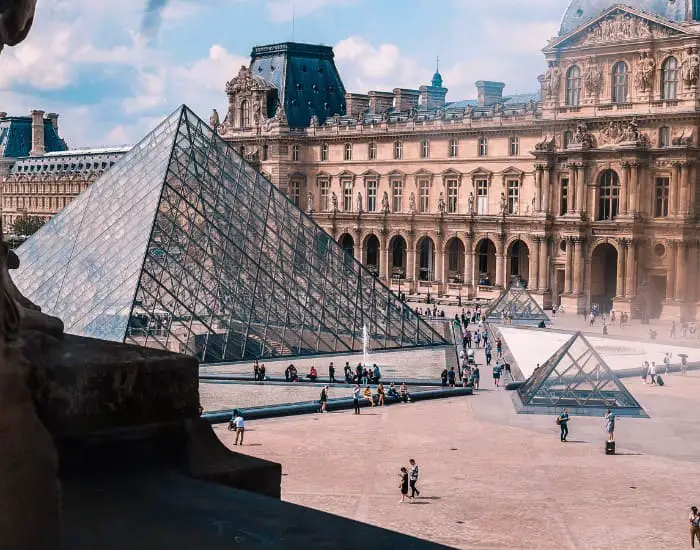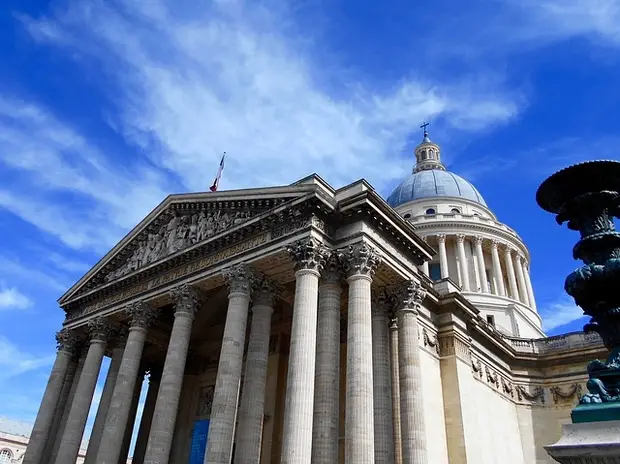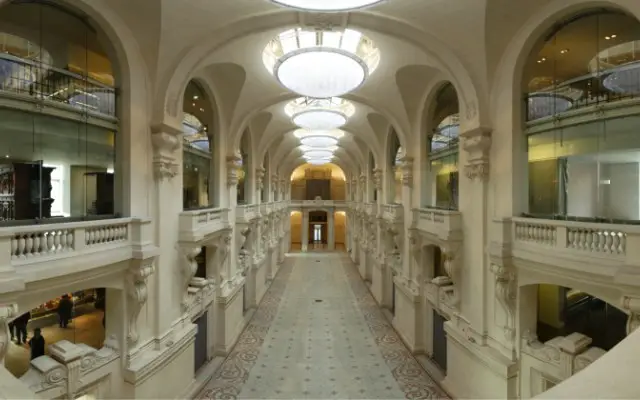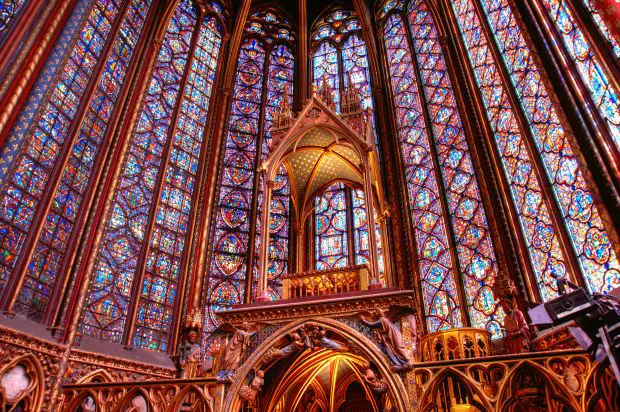Paris is a magnificent city that has been constantly evolving for centuries. Whether the Louvre or the Arc de Triomphe, its monuments have also aged and evolved over time. Let’s discover these monuments and the streets of the capital over the centuries through both old and new photos.
Arc de Triomphe
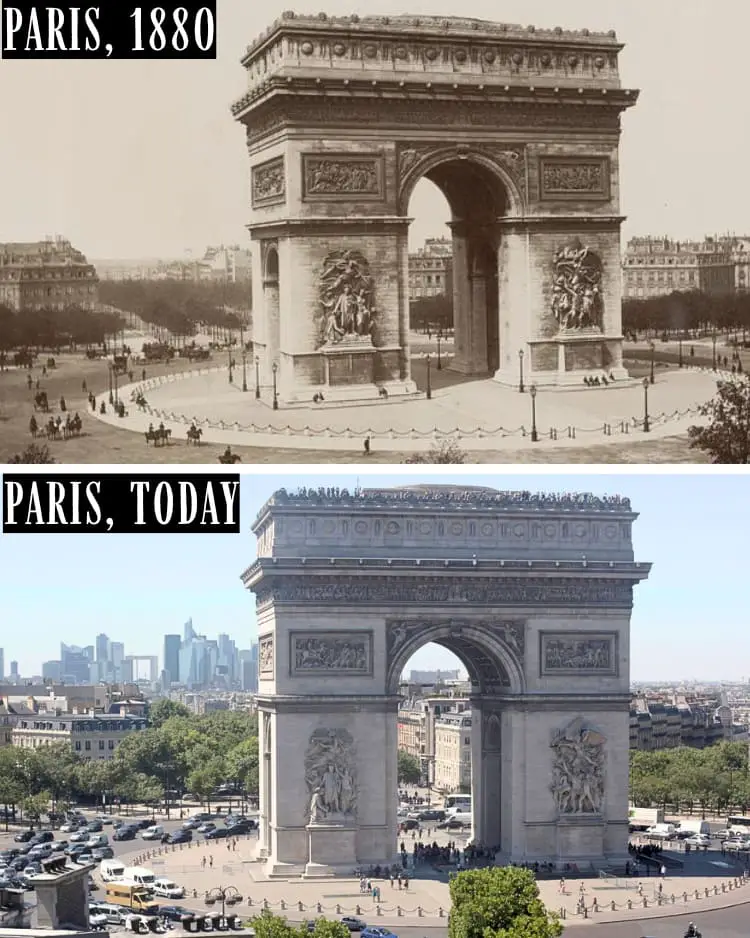
While the Arc de Triomphe itself hasn’t changed since it was completed in 1836, traffic has certainly increased since then.
The vegetation has also increased, but the buildings remain unchanged, retaining their original style.
This consistency shows the attention that France gives to its monuments, conserving this quintessential Parisian landmark over decades.
Place Vendôme
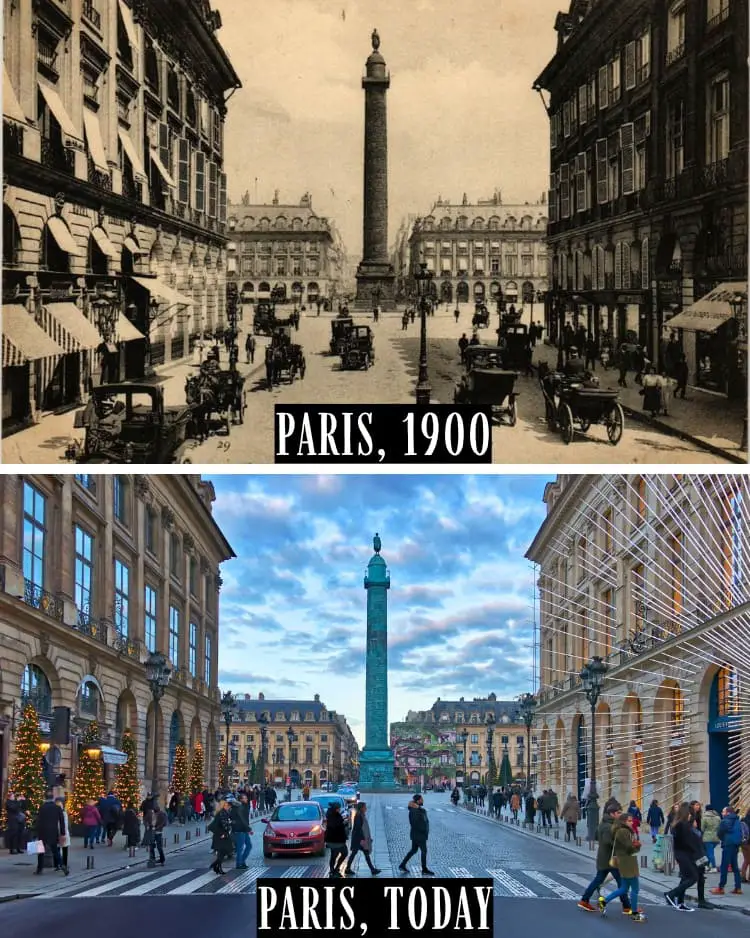
The Place Vendôme, begun in 1686, is the symbol of luxury in the city of fashion.
The square has become much more pedestrian-friendly over the years. Now, there is only a small stretch of road devoted to cars,unlike 100 years ago.
We can also assume that there are more tourists, as the first photo seems to show Parisians going about their business, whereas the recent photo shows a crowd of tourists.
The public has certainly changed over the last hundred years!
Eiffel Tower, view from the Trocadéro
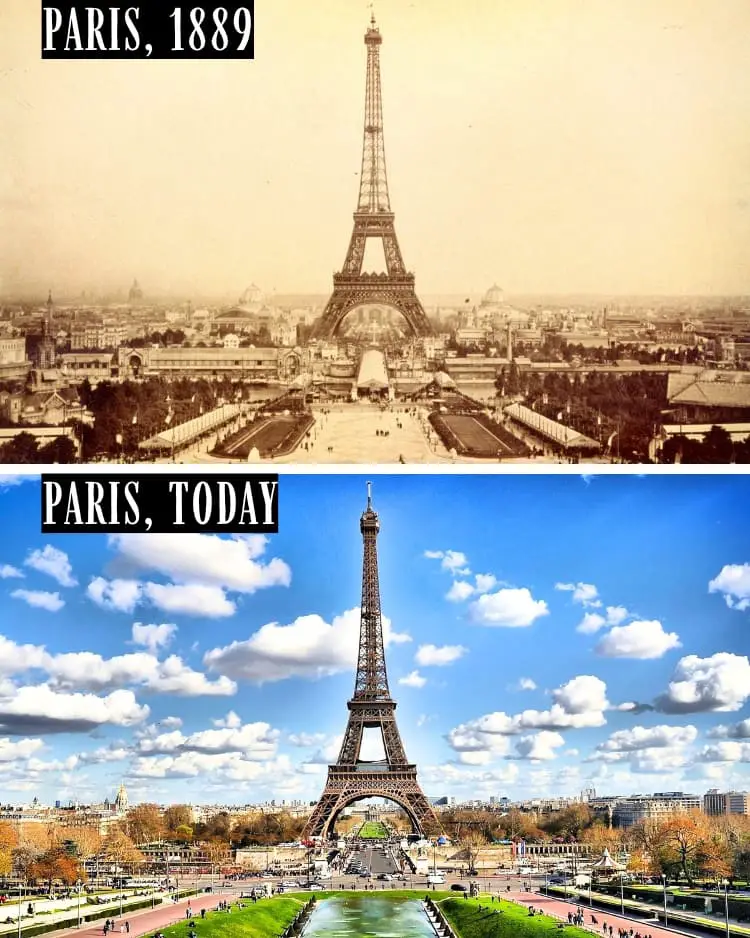
The Eiffel Tower opened in 1889 for the World’s Fair held in Paris. At the time, it was the tallest structure in the world.
The area around it, now the Trocadéro Gardens, was built differently back then, with large exhibition halls that no longer exist today.
The tower was originally meant to be temporary, but it became permanent and is now the most visited paid monument in the world.
Hôtel de Ville

This is the Hôtel de Ville, the Paris City Hall. The current building was finished in 1882, after the original was destroyed by fire during the Paris Commune in 1871. Its exterior hasn’t changed much since 1900.
What’s different today is the large public square in front, now used for events, markets, and fountains.
The area around it has also been made more pedestrian-friendly.
Place de la Concorde

This is Place de la Concorde, the largest square in Paris. The Luxor Obelisk in the center has been there since 1836.
In the 1920 photo, the square is already a busy traffic hub with early cars.
Today, the layout is similar, but there are modern streetlights, more traffic control, and the area is now better designed for pedestrians and events.
The buildings in the background remain mostly unchanged.
Passage des Panoramas
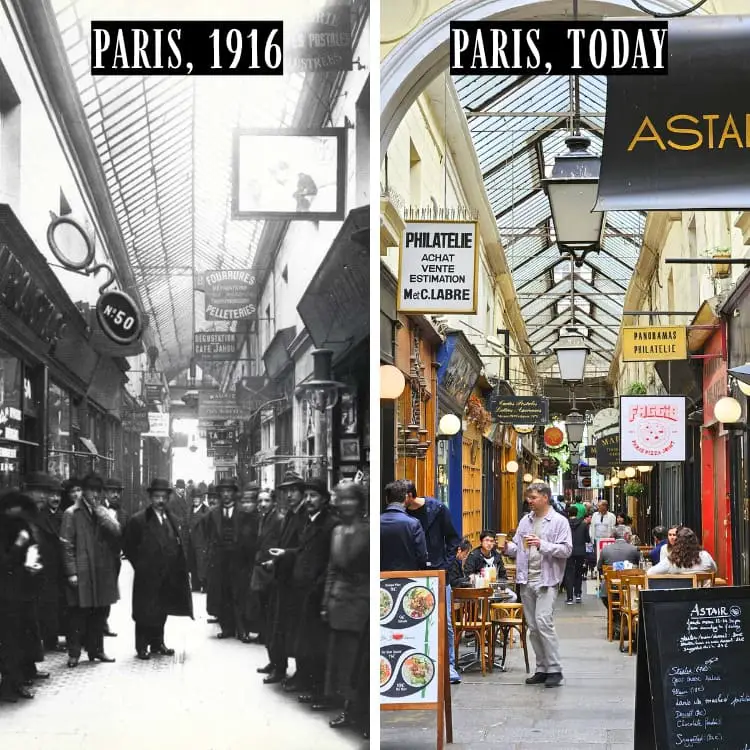
The Passage des Panoramas is the oldest covered passage in Paris!
Built in 1799, the passage has been home to traditional shops for centuries, and as you can see from both pictures, there aren’t that many differences.
Lanterns add to its characteristic picturesque style, and the luxury shops, bootmakers, goldsmiths, toy sellers, and booksellers have given way to a number of small restaurants, stamp and postcard shops, antique shops, and exhibition and art events.
Moulin Rouge
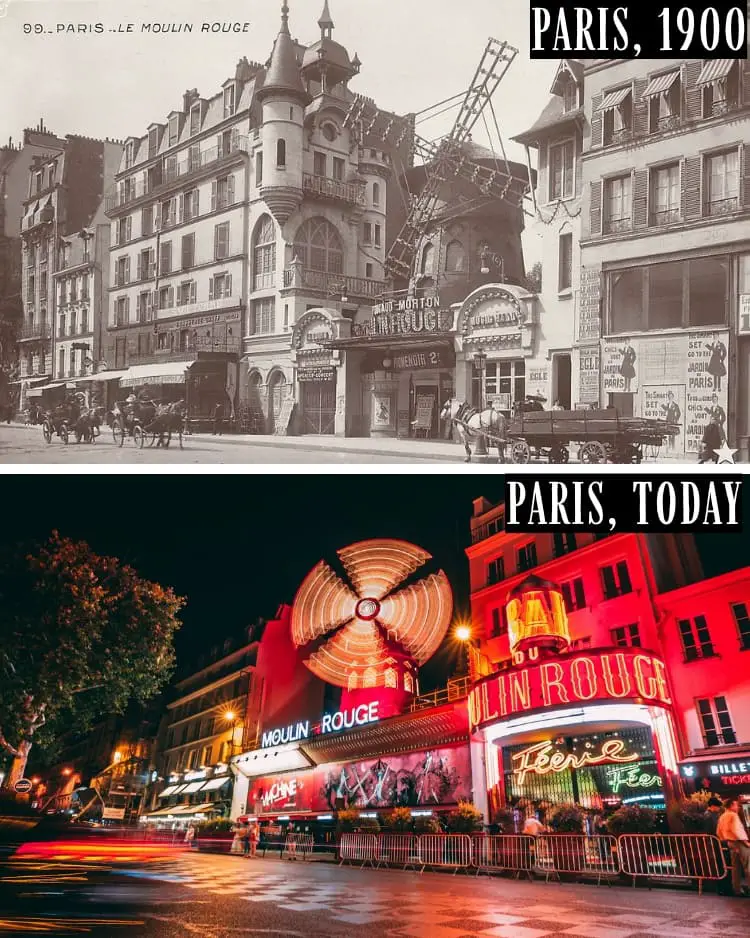
This is the Moulin Rouge, the famous cabaret in Montmartre, opened in 1889.
The red windmill on top has always been its symbol. In 1900, the building had more decorative towers and turrets, which were removed after a fire in 1915.
Today’s version is simpler but brighter, with neon lights and modern signage.
The venue still hosts shows every night and remains one of the most popular nightlife spots in Paris.
The Louvre
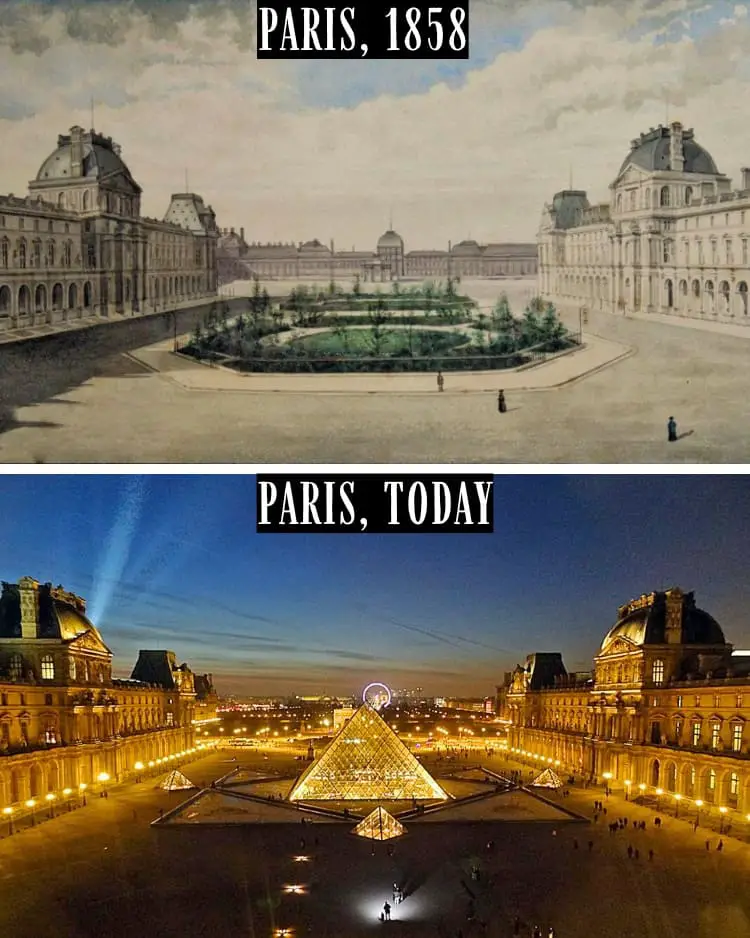
This is the Cour Napoléon, the main courtyard of the Louvre Palace.
In 1858, it was a quiet garden space with trees and a round lawn.
The large glass pyramid, now the main entrance to the Louvre Museum, was added in 1989, designed by architect I.M. Pei. The garden was removed to open up the space and improve visitor flow.
Today, the pyramid and fountains are iconic symbols of the museum and often lit up at night.
Rue de l’Abreuvoir
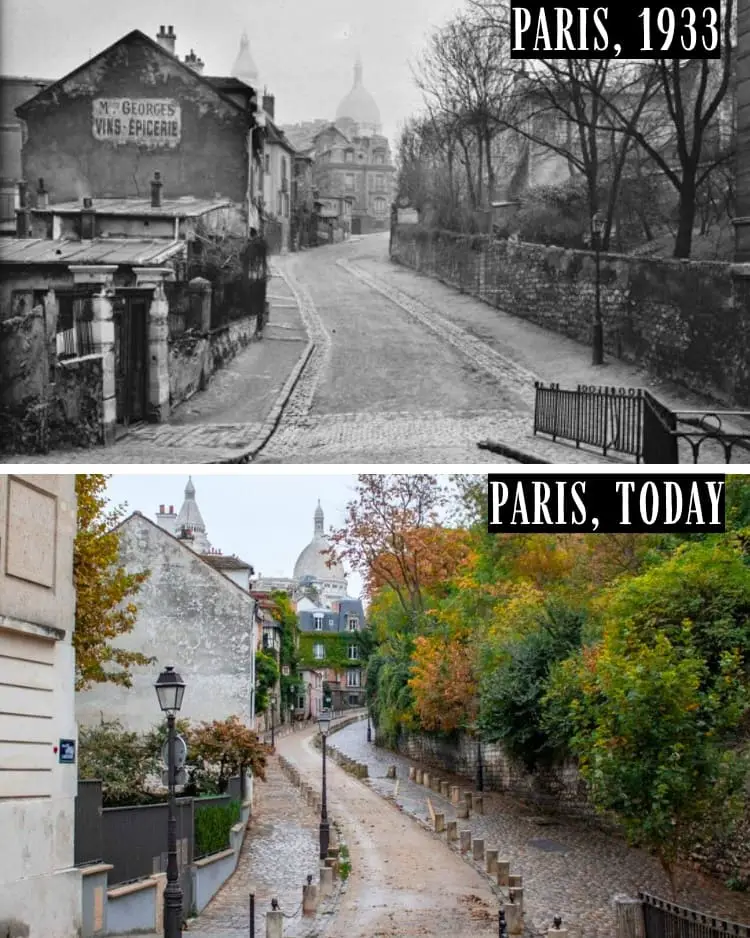
This is Rue de l’Abreuvoir in Montmartre, shown in 1933 and today.
The street layout and cobblestones have stayed the same, and the view of the Sacré-Cœur in the background is still a highlight.
While the surroundings look more maintained now, the area has kept its original charm and is one of the most photographed streets in Paris.
Musée d’Orsay

The Musée d’Orsay has transformed remarkably since its origins as the Gare d’Orsay, a train station built in 1900 to welcome travelers into Paris.
While the station once bustled with activity, it eventually became ill-suited for the larger, modern trains of the mid-20th century and fell into disuse by the 1970s.
Rather than demolish the striking structure, France chose to preserve its grandeur, reimagining it as an art museum.
Since its opening in 1986, the Musée d’Orsay has become a treasure trove of 19th and early 20th-century masterpieces, featuring works by Monet, Van Gogh, and Degas.
This evolution reflects France’s dedication to honoring its heritage by giving new purpose to its architectural landmarks.
Bouquinistes
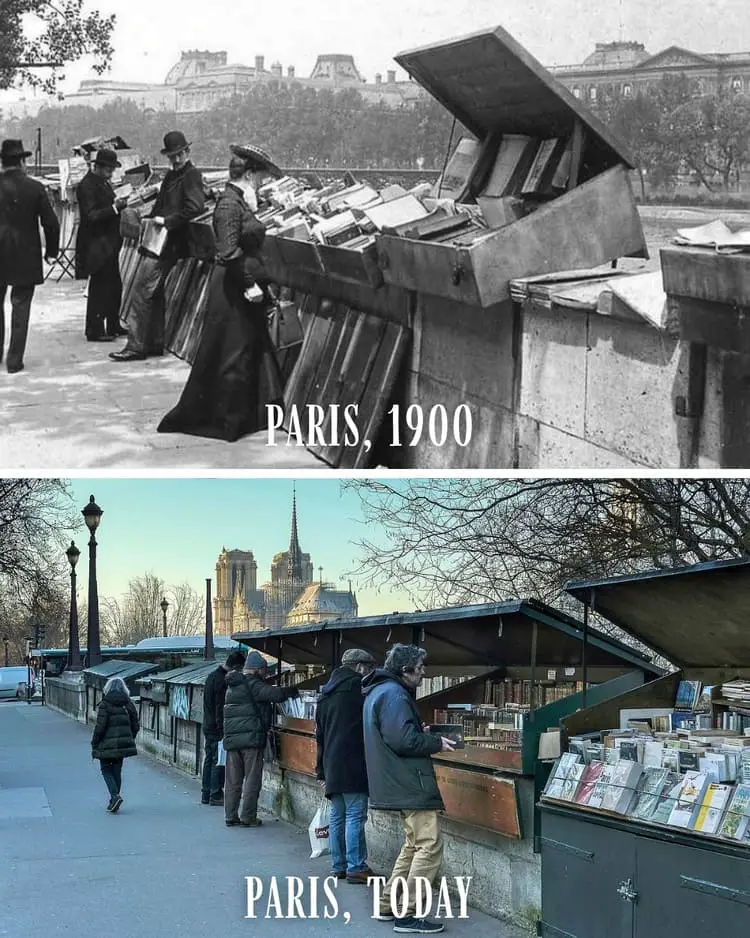
Along the banks of the Seine, the ‘bouquinistes’ have been part of Parisian tradition for centuries, selling rare books, old postcards, posters and charming souvenirs from their famous green boxes.
Rue Félix-Ziem

Rue Félix-Ziem, located in Montmartre, is a quiet and picturesque street that reflects the charm of this historic Parisian district.
Flanked by traditional buildings and surrounded by the artistic ambiance Montmartre is known for, it offers a serene escape from the bustling city.
Named after the 19th-century French painter Félix Ziem, the street pays homage to Montmartre’s rich artistic heritage, making it a fitting part of this storied neighborhood.
Passage Cottin

Passage Cottin, nestled in the heart of Montmartre, is a haven of tranquillity that reveals the discreet charm of this historic district.
Lined with picturesque staircases and little houses with flower-filled facades, it embodies the timeless, bucolic atmosphere of Montmartre.
This typically Parisian passageway offers an enchanted interlude away from the hustle and bustle, while testifying to the authenticity and unique character of this emblematic corner of the capital.
Rue Sainte-Rustique
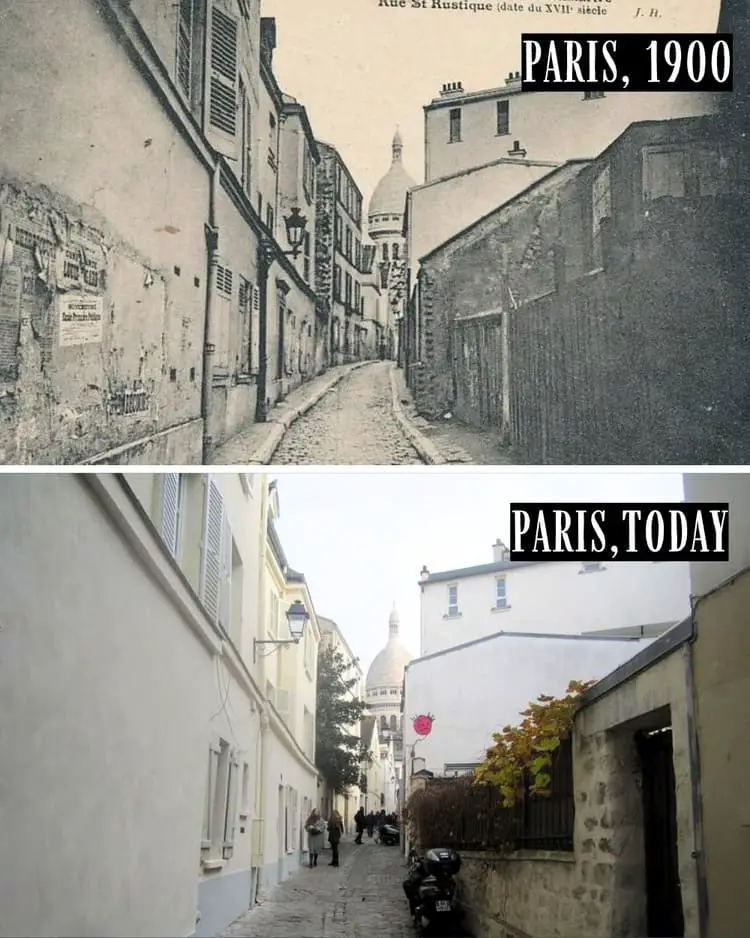
Rue Sainte-Rustique, in the heart of Montmartre, is one of the oldest and most charming streets in the district.
With its ancient cobblestones and typical façades, it seems frozen in time, offering an authentic and picturesque atmosphere.
Lined with cafés and small shops, it links Place du Tertre to Saint-Pierre de Montmartre church.
This street, steeped in history, perfectly embodies the timeless charm of Montmartre, where every corner seems to tell a story.
Opéra Garnier

The Opéra Garnier, one of Paris’s most emblematic monuments, is a masterpiece of the Beaux-Arts style.
Built between 1860 and 1875 by the architect Charles Garnier under the reign of Napoleon III, it embodies the elegance and refinement of Parisian architecture.
With its richly ornate façade and sumptuous interior, the Opéra Garnier bears witness to the prestige of its era, while continuing to amaze with its grandeur and timeless splendour.
Passerelle Debilly
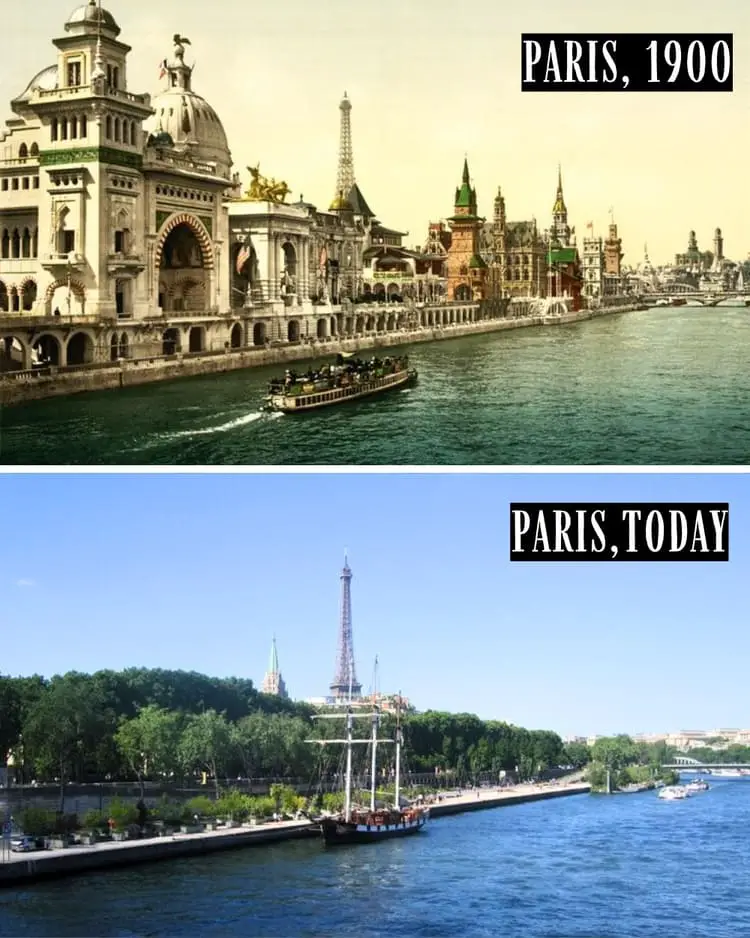
At the 1900 Universal Exhibition, Paris was transformed by large temporary pavilions representing nations such as the United States, the Ottoman Empire and Germany.
Set up along the Seine, these spectacular structures, visible in the first image, were demolished after the event.
The Passerelle Debilly, built for the occasion, still stands as a reminder of that era.
In the background, the former Palais du Trocadéro, which once dominated the hill of Chaillot, has since given way to the current Palais de Chaillot.
The Opéra Garnier under the German occupation
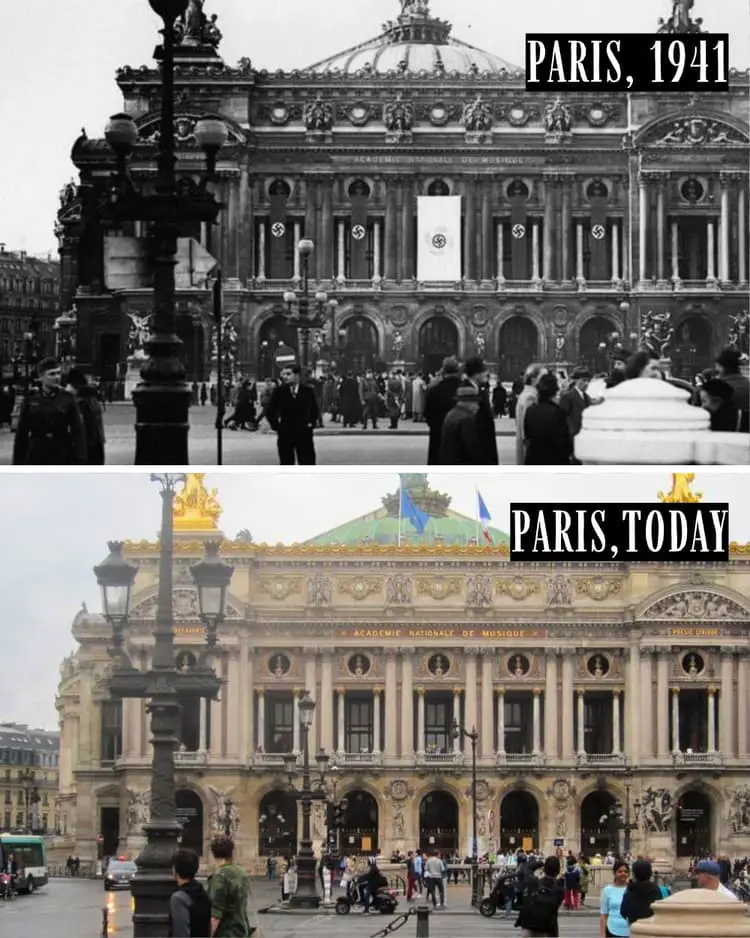
This is the Opéra Garnier, photographed in 1941 during the German occupation of Paris, and today.
In 1941, this majestic building was decorated with Nazi flags for a music festival organised by the occupiers.
Events such as concerts, including one given by the Berlin Philharmonic conducted by Herbert von Karajan, aimed to promote German culture in the occupied capital, marking a dark chapter in the history of this emblematic venue.
Place du Caire

Here is the Place du Caire, located in the 2ᵉ arrondissement of Paris, photographed in 1914 and today. Named after Cairo, it bears witness to Napoleon’s Egyptian expedition in 1798.
In 1914, the square was bustling with merchants selling signs and bakery products.
At the top of the image is a public urinal, typical of the Parisian landscape until the 20ᵉ century.
The two advertising columns, symbols of old Paris, were removed in 2006 despite numerous protests.
Boulevard Saint-Martin

Boulevard Saint-Martin, as it appeared around 1900, is one of Paris’s famous Grands Boulevards.
A symbol of Haussmannian elegance, this boulevard embodies the dynamism of Paris at the turn of the 20ᵉ century, offering a glimpse of the capital’s effervescence and timeless charm.
Théâtre de la Renaissance

The Théâtre de la Renaissance, built in 1873, stands out on the Boulevard Saint-Martin for its Italian Renaissance-style architecture, inspired by the Opéra Garnier.
With its elegant facades and architectural refinement, it embodies Paris’s rich cultural and artistic heritage, adding to the timeless charm of the Grands Boulevards.
Notre-Dame de Paris forecourt
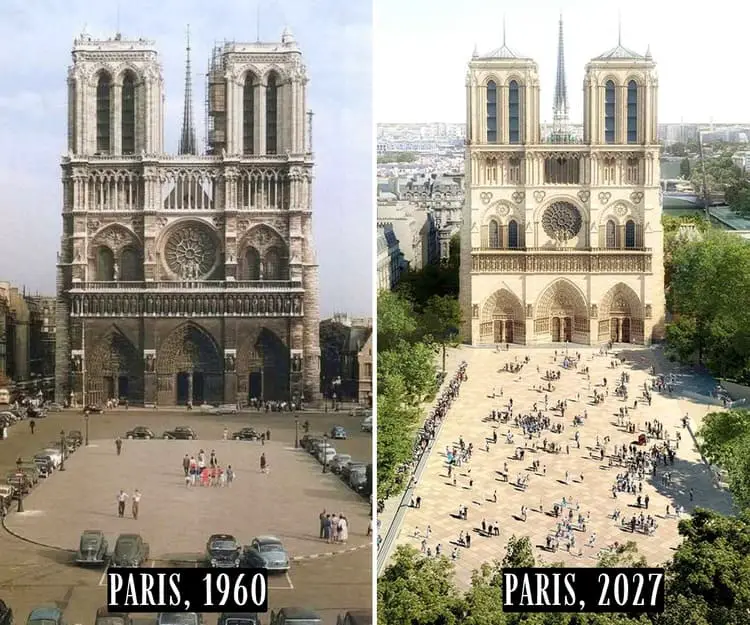
Here’s a comparison of the Notre-Dame forecourt between 1960 and what it should look like in 2027.
This emblematic space, located opposite the cathedral, is being transformed to become more welcoming and climate-friendly.
The new forecourt will incorporate shaded areas thanks to the planting of 160 trees, a fine sheet of water to cool the air on hot days, and limestone paving to highlight Notre-Dame’s iconic façade.
In the basement, the former car park will give way to a cultural space with a bookshop, café and access to the archaeological Crypt.
Place Saint-Michel

Place Saint-Michel and its eponymous fountain form one of Paris’s iconic landmarks.
Located in the heart of the Latin Quarter, this lively square is dominated by the Fontaine Saint-Michel, a monumental 19thᵉ century work depicting the Archangel Michael striking down the devil.
A symbol of Haussmannian elegance, this space remains a popular meeting point, where Parisian history and dynamism come together harmoniously.
Rue de l’Abbaye

This is Rue de l’Abbaye in Paris, a quiet street close to the iconic church of Saint-Germain-des-Prés.
With its peaceful atmosphere and typical buildings, this street evokes the discreet charm of the district, offering a soothing contrast to the bustle of the neighbouring streets.
Rue de la Montagne-Sainte-Geneviève
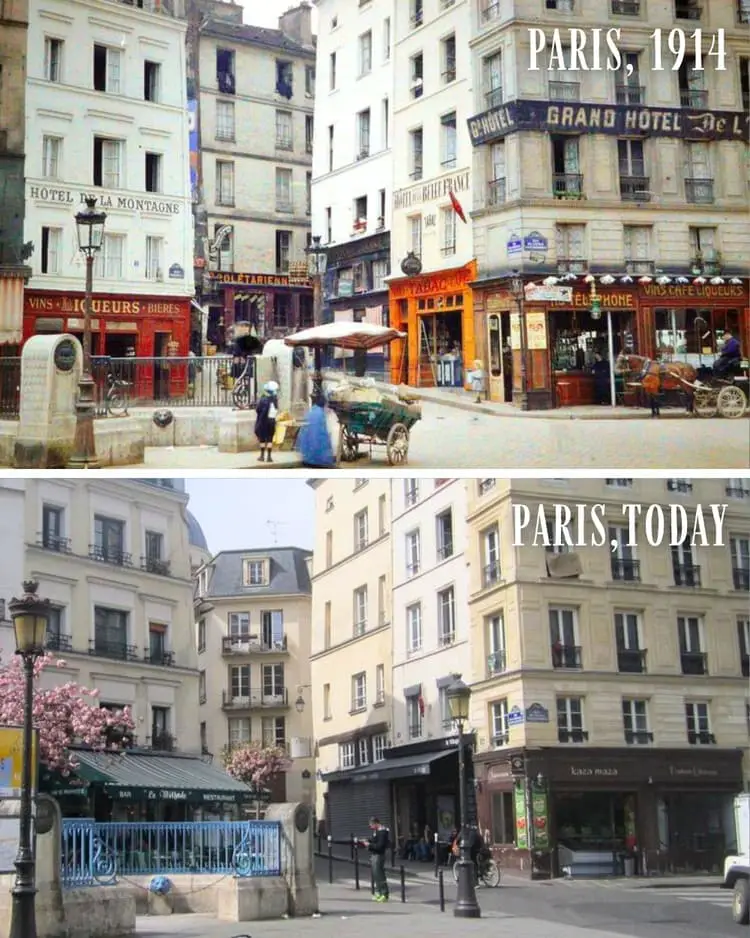
This is the Rue de la Montagne-Sainte-Geneviève, a historic street in the Latin Quarter of Paris, shown here in 1914 and today.
This street, which retains its character of yesteryear, bears witness to the evolution of the district while preserving the authentic atmosphere that makes it such an emblematic part of Paris.
Pont Alexandre III
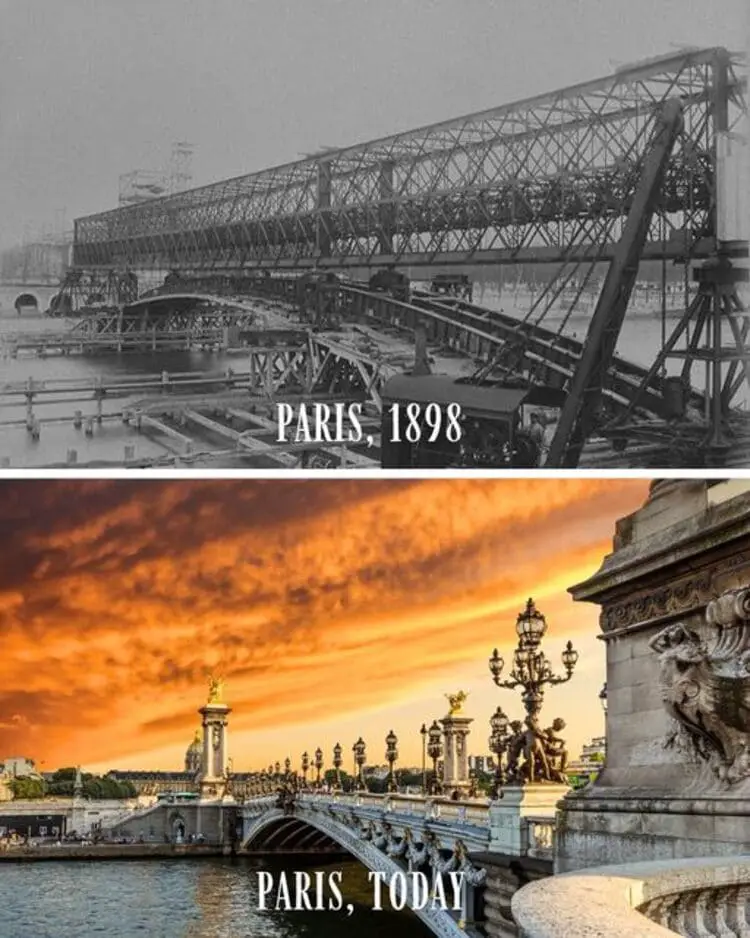
The Pont Alexandre III is one of the most beautiful and famous bridges in Paris.
Built between 1896 and 1900, it links the Champs-Élysées district to the Invalides.
The bridge is named after Tsar Alexander III of Russia, symbolising the friendship between France and Russia.
It is renowned for its breathtaking decorations, with gilded statues, elegant lamps and sculptures of angels, which give it a unique charm and majesty, contributing to the splendour of the Parisian landscape.
Printemps Haussmann
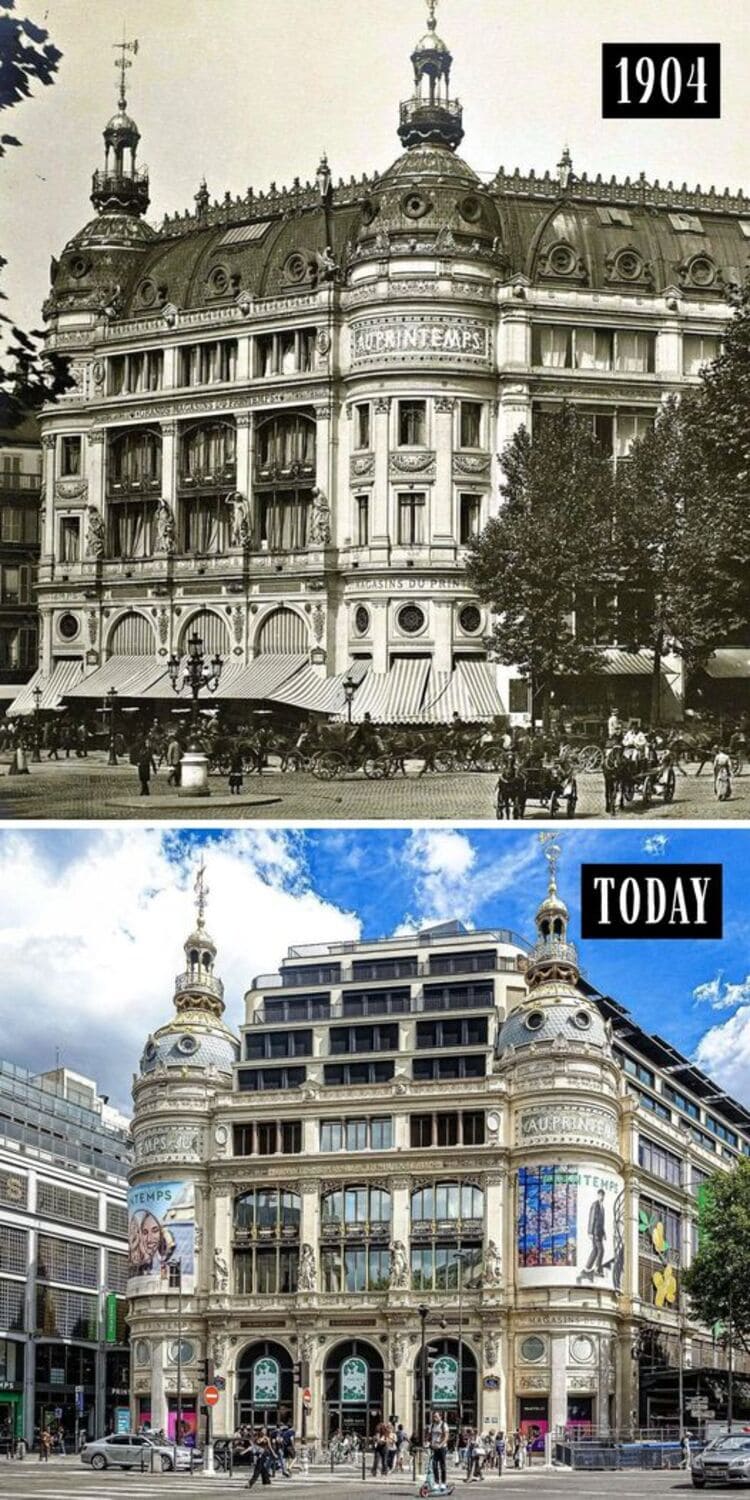
Located on Boulevard Haussmann, this temple to shopping embodies Parisian elegance and luxury.
Since it opened in the early 20ᵉ century, it has evolved while preserving its refined architecture, with an iconic glass dome, still attracting visitors looking for high-end products in a historic setting.
École Polytechnique in Paris
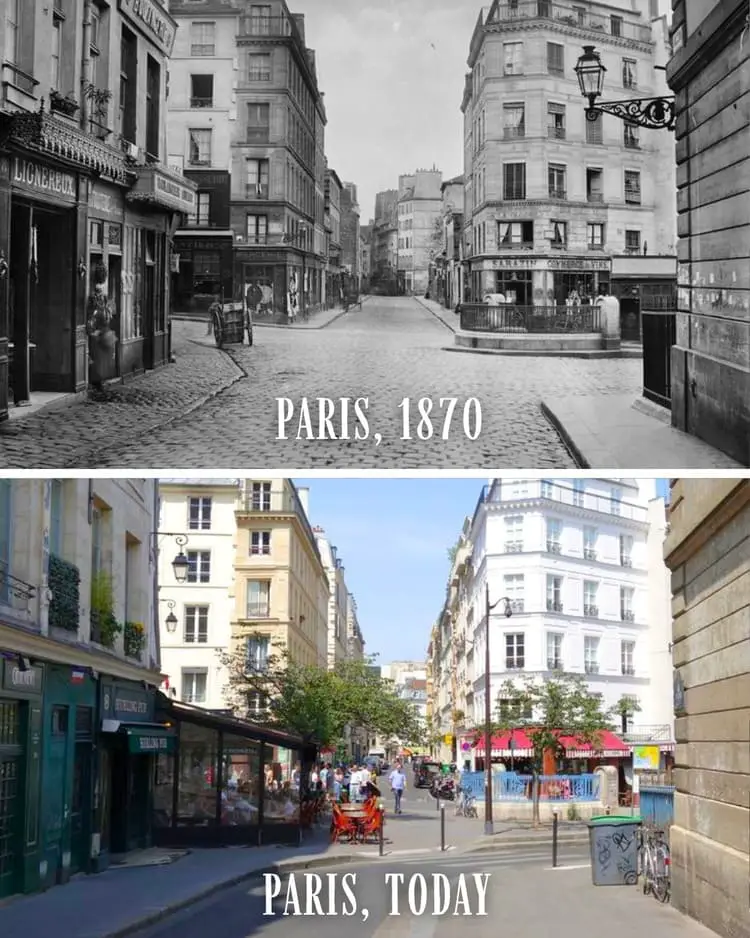
Here’s a look at the Rue de l’École Polytechnique in Paris, comparing 1870 and today.
Once lined with horse-drawn carriages and old-fashioned shops, this street is now bustling with modern cafés and restaurants.
Located in the Latin Quarter, a historic area renowned for its student life, it has retained its charm while adapting to contemporary life.
Hôtel Regina

In 1918, the building was decorated with American flags to celebrate the end of the First World War.
At the time, it housed the headquarters of the American Red Cross.
Today, the same building has become the Hotel Regina, standing proudly next to the gilded statue of Joan of Arc.
Louvre’s Grande Galerie

During the First World War, the Louvre’s Grande Galerie was emptied to protect its treasures.
Paintings, including masterpieces, were packed up and sent to Toulouse for safekeeping.
Later, during the Second World War, many works of art were moved to châteaux in the Loire Valley, such as the Château de Chambord.
Today, this magnificent gallery exhibits Italian masterpieces dating from 1250 to 1800, welcoming visitors from all over the world.
Les Halles
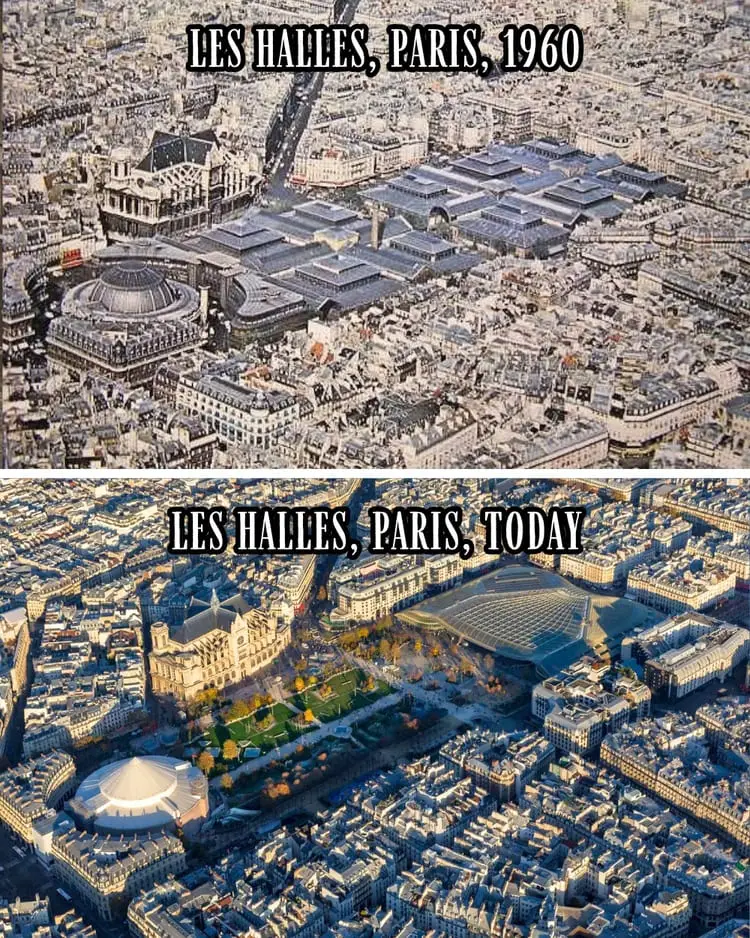
Les Halles, in the heart of Paris, was once the city’s main food market, packed with merchants selling fresh produce, meat and seafood.
Nicknamed the ‘belly of Paris’, it supplied the entire capital.
In 1969, the market was moved to the suburbs (to Rungis), and the area was transformed.
Today, it is a modern commercial and cultural centre with a park and the Forum des Halles, a huge underground shopping centre.
The atmosphere is still lively, but the place has changed completely since the days of the market.
Grand Palais
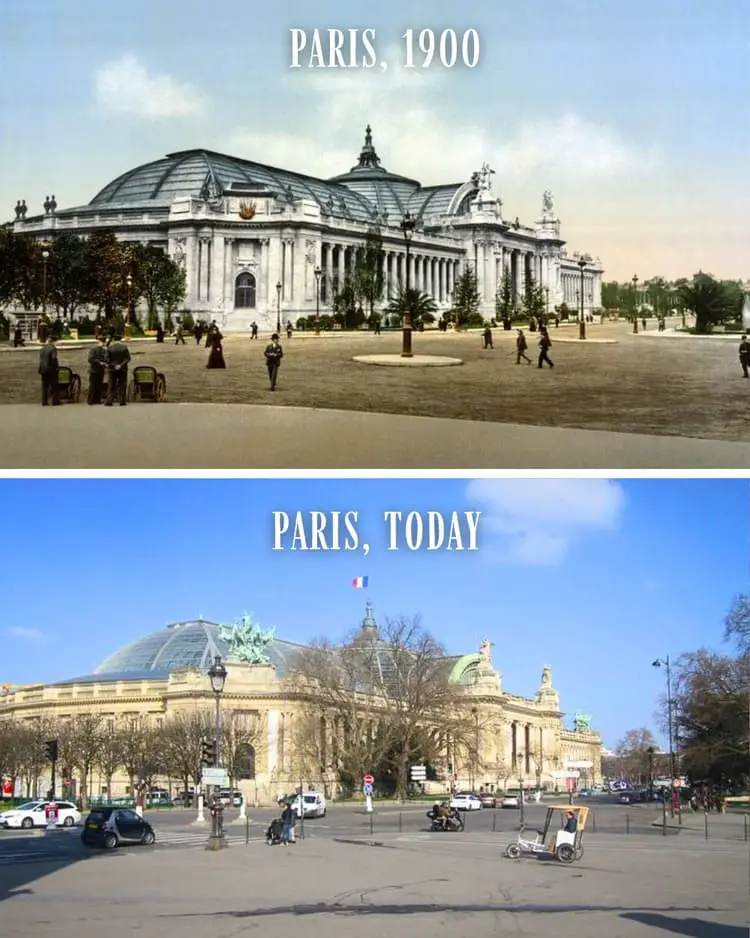
The Grand Palais is a magnificent historic building in Paris, built in 1900 for the Universal Exhibition.
Renowned for its incredible glass roof, it hosts art exhibitions, fashion shows and various events throughout the year.
With its blend of classical and modern architecture, it remains one of the city’s most iconic cultural monuments.
Les Halles and the Saint-Eustache church
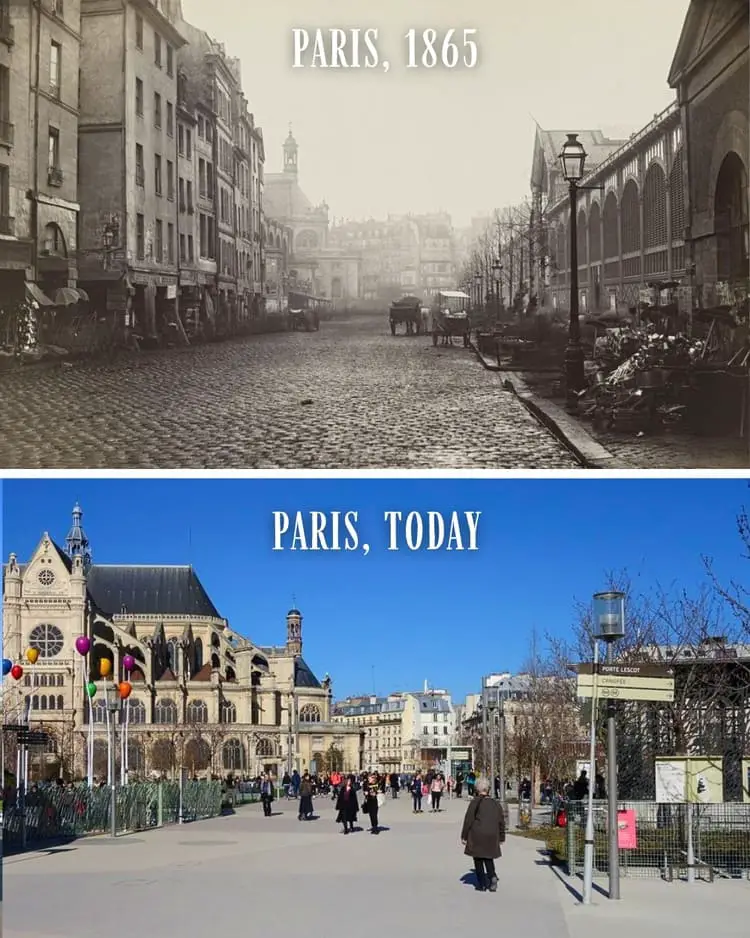
The Halles district, with its emblematic Saint-Eustache church.
In the heart of Paris, this area retains its historic charm, with the church of Saint-Eustache, a masterpiece of Gothic architecture, still an essential landmark in the midst of the district’s modern transformations.
Rue de Venise

This is the Rue de Venise in Paris, in the Marais district, photographed around 1905 and today.
Once known as ‘one of the last medieval alleyways’, its narrow layout remains a testament to Paris’s historical past.
Pont Bir Hakeim
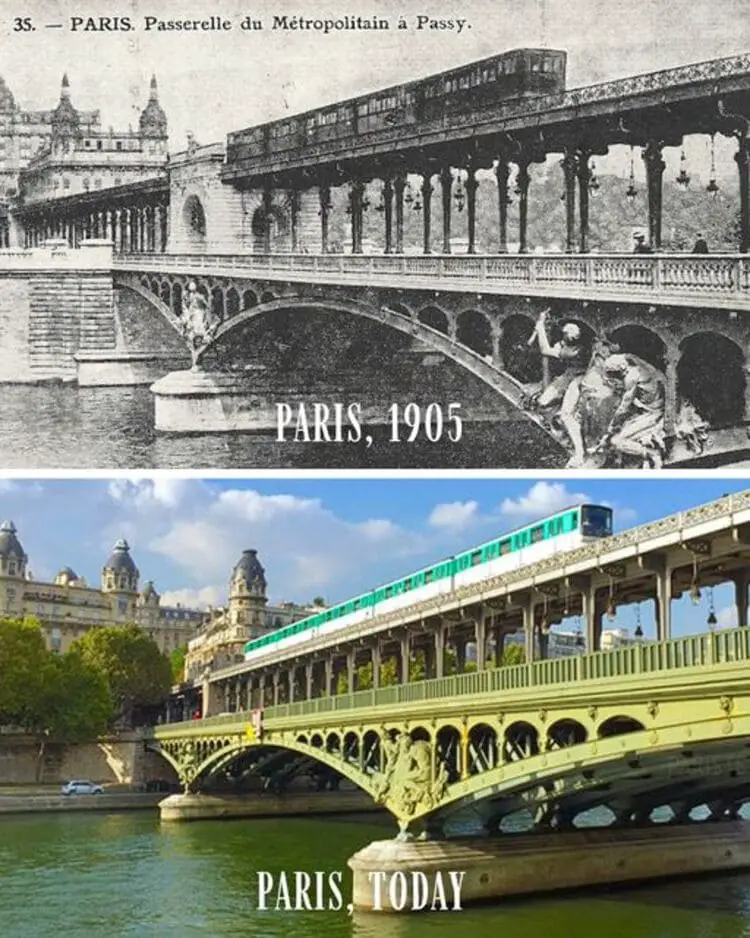
This emblematic bridge, which crosses the Seine, has preserved its historic charm while adapting to the changing face of the city.
Known for its metal arches and its role in a number of films, it remains a symbol of Parisian architecture, offering unbeatable views of the river and the capital.
Rue Saint-Dominique
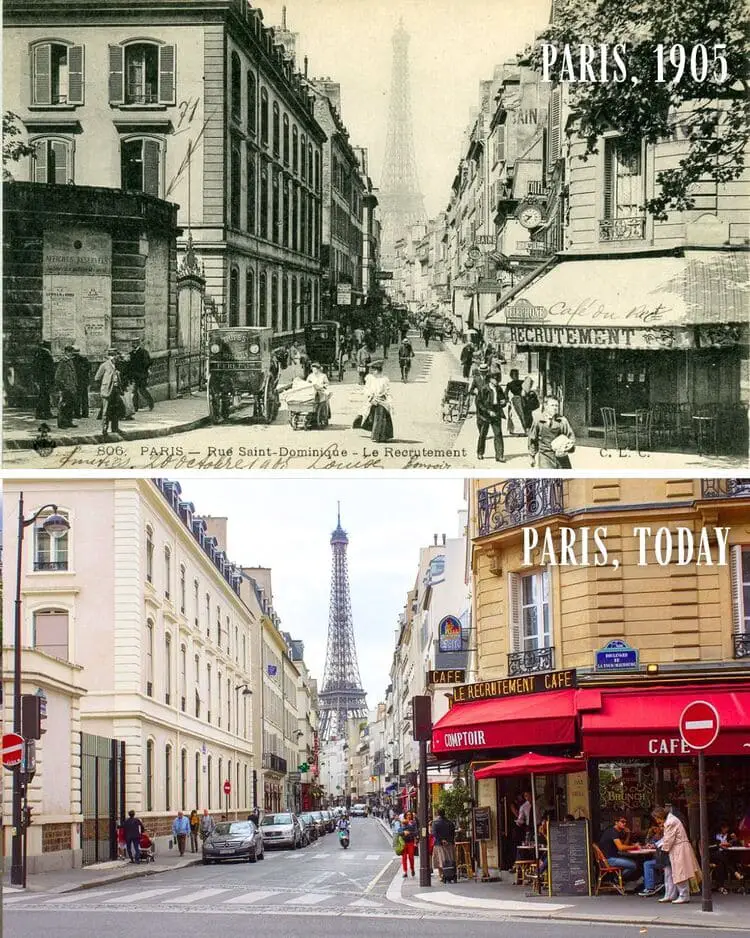
Rue Saint-Dominique and the view of the Eiffel Tower – a timeless image of Paris!
More than a century has passed, but this charming street still captures the magic of Paris, with its welcoming cafés like Le Recrutement and that perfect view of the Iron Lady in the background.
Avenue Foch
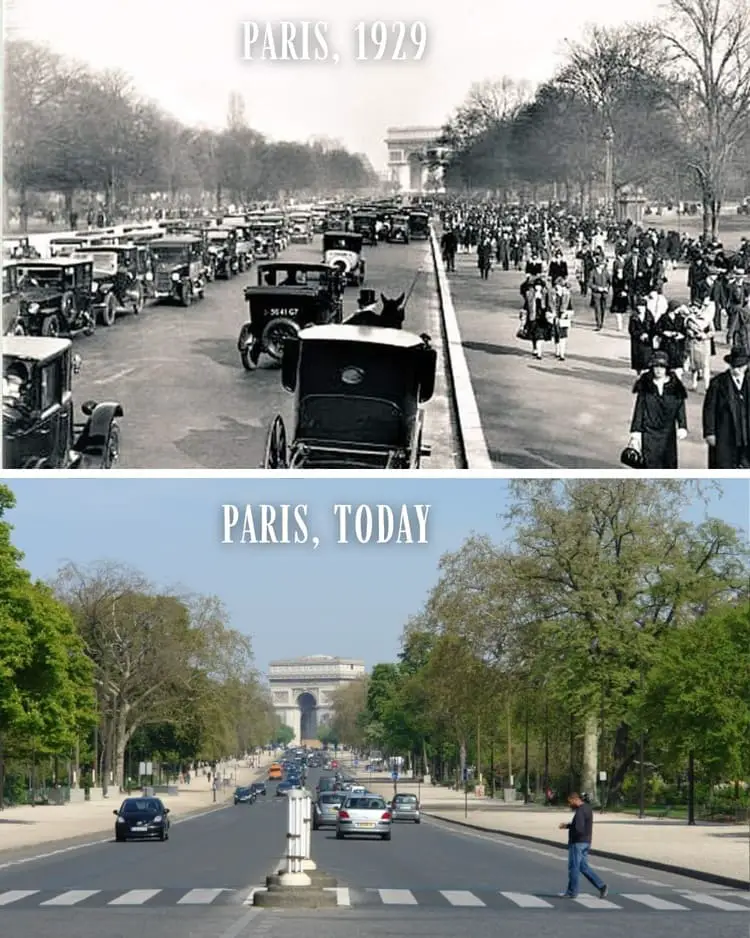
Avenue Foch in Paris, a wide, elegant boulevard, is one of the capital’s most prestigious avenues.
Lined with sumptuous Haussmann façades and private gardens, it is the epitome of Parisian luxury, with breathtaking views of the Arc de Triomphe.
This quiet, refined avenue remains a symbol of chic, historic Paris.
Le Lapin Agile

This photo captures Le Lapin Agile, an iconic cabaret nestled in Montmartre, Paris.
Since the 19th century, it has served as a vibrant hub for creativity, drawing renowned artists, writers, and musicians.
Figures like Picasso, Apollinaire, and Renoir once gathered within its walls, exchanging poems, songs, and ideas.
Le Lapin Agile remains a testament to Montmartre’s artistic legacy, preserving the spirit of a bygone era while continuing to inspire those who visit its historic space
Rue Volta
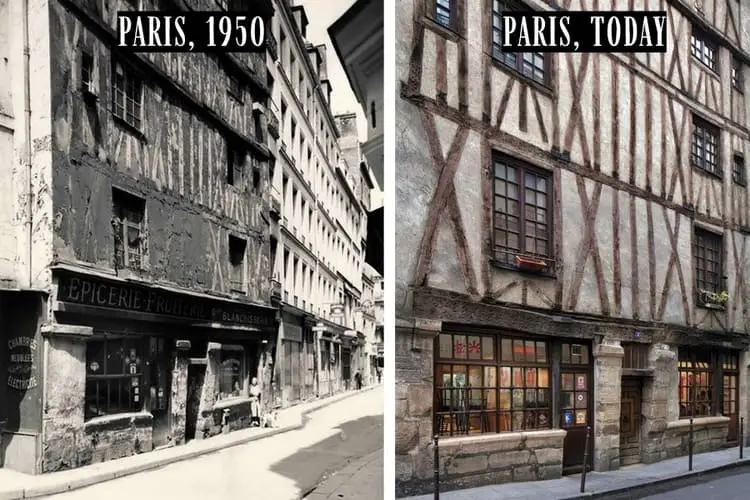
The building at 3 Rue Volta, nestled in the Marais district of Paris, stands as a striking relic of medieval architecture, dating back to the 14th century.
Its timber-frame structure, adorned with wooden beams and small windows, offers a rustic charm that contrasts with the more modern surroundings.
Once believed to be the oldest house in Paris, later research revealed that a building on Rue de Montmorency holds that title.
Still, 3 Rue Volta remains a captivating glimpse into the city’s medieval past, preserving its unique character amidst the ever-evolving urban landscape.
The View from Arc de Triomphe

The view from the Arc de Triomphe is truly unforgettable! The view from the top of the Tour Montparnasse is one of my favorites.
In these pictures, you can see that some buildings have been modified over the years and a metro station has been built, seen on the left of the central building in the picture.
The sidewalks have also been reduced to widen the traffic lane.
In the other two photos, you can see that the vegetation is more lush and some buildings have been renovated The Ferris Wheel from the 1900 Paris Exhibition, which was destroyed in 1920, is also visible in the image.

Rue Soufflot with the Panthéon in the background
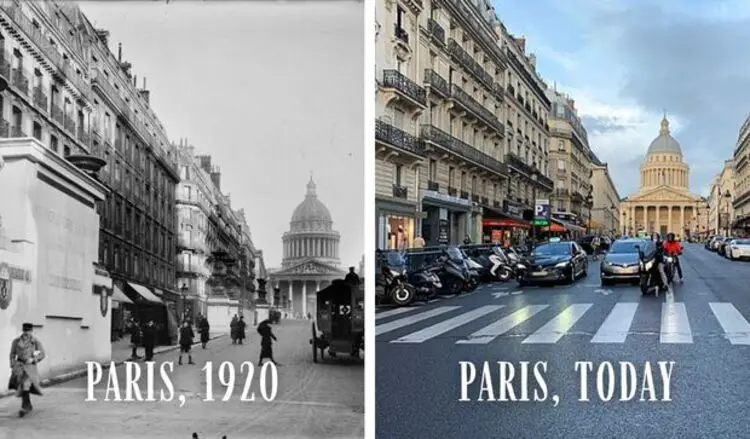
November 11th, 1920 on the Rue Soufflot was a solemn occasion!
As you can see, it was decorated for Armistice Day, with stone pedestals along the street to commemorate the death of Léon Gambetta and the Unknown Soldier, who were later laid to rest in the Panthéon and under the Arc de Triomphe, respectively.
Today, the Panthéon can be admired from the street, adding some cachet to the place.
Place des Pyramides
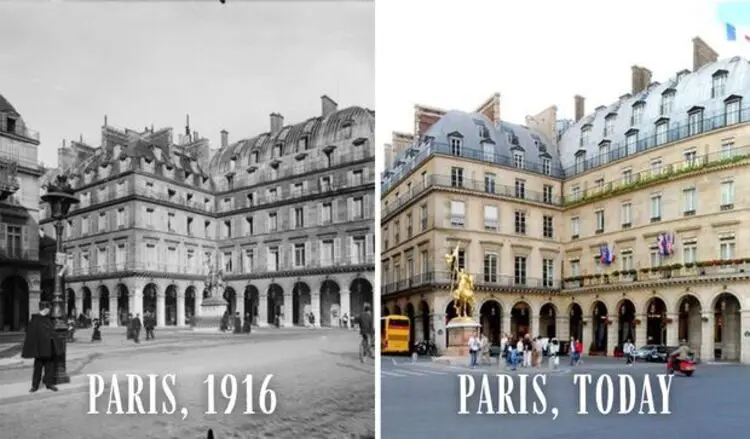
The Place des Pyramides, formerly known as Place de Rivoli because of its location, was inaugurated in 1801.
Between these two pictures, you can see that the buildings have been renovated and look cleaner, and the road has been paved, making it easier for cars to get around.
Passage Cottin

This photo shows Passage Cottin from 1900 and today. Even though a hundred years separate these pictures, the street looks almost the same.
The same old charm is still there, and the style of the buildings hasn’t really changed.
It’s like the street is a time capsule, keeping its special look no matter how much time passes.
Place du Tertre
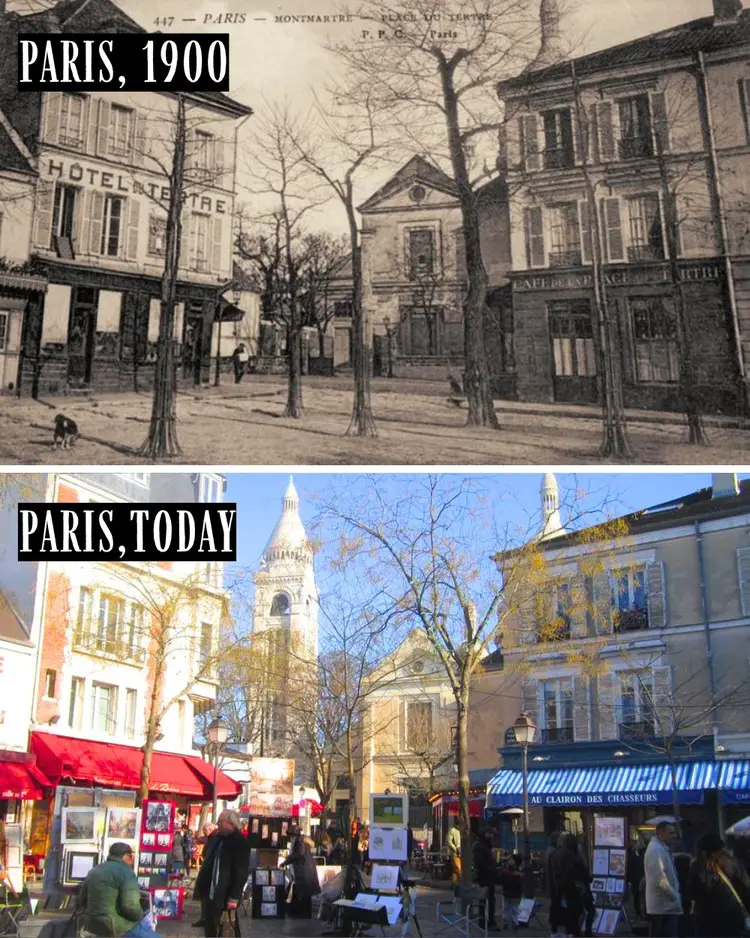
This photo shows Place du Tertre from 1900 and today.
In the old picture, you don’t see the tower behind the Hotel du Tertre, but today it stands there.
Even with that difference, the square still has the same friendly, charming feeling as long ago, with its little cafes and busy art scene that make it special.
Rue Caulaincourt

This photo shows Rue Caulaincourt from 1900 and today. In the old picture, the street was quiet with small buildings and people in old-fashioned clothes.
Today, even though there are some modern touches like new signs and cars, the street still keeps its special charm and the same kind of old style.
It’s like the heart of the street stayed the same even as time passed.
The Seine Riverside

This photo shows Paris during the 1900 World Fair. On the left side of the river, temporary buildings from different countries line the banks.
You can see pavilions from the United States, Austria, Hungary, Britain, Belgium, Norway, Germany, Spain, and Monaco, each built in a special way to show off its culture.
On the right side of the river, there’s a big building called the Pavilion of the City of Paris, and in the distance, you can even spot the two towers of the old Trocadéro Palace, which was later replaced by the Palais de Chaillot in the 1930s.
Palais de Chaillot

This photo shows the building of the Palais de Chaillot in 1936 compared to how it looks today.
It was constructed for the 1937 Paris World’s Fair.
Fair to replace the old Trocadéro Palace.
The new design featured two large curved wings with open spaces in the middle, offering beautiful views of the Eiffel Tower.
Today, the Palais de Chaillot is home to museums and theaters, and it sits next to the Trocadéro Gardens—a favorite place where visitors go to admire the Eiffel Tower.
La Fontaine de Mars

This photo shows La Fontaine de Mars on Rue Saint-Dominique in Paris.
The fountain was built in 1806 during Napoleon Bonaparte’s time to bring clean drinking water to the people.
It is decorated with classical sculptures, including a relief of Mars, the Roman god of war, which is why it’s named La Fontaine de Mars.
Today, the fountain is still a beautiful landmark, surrounded by charming restaurants like the famous Brasserie Fontaine de Mars, where visitors can enjoy a meal while admiring its history.
Pont des arts
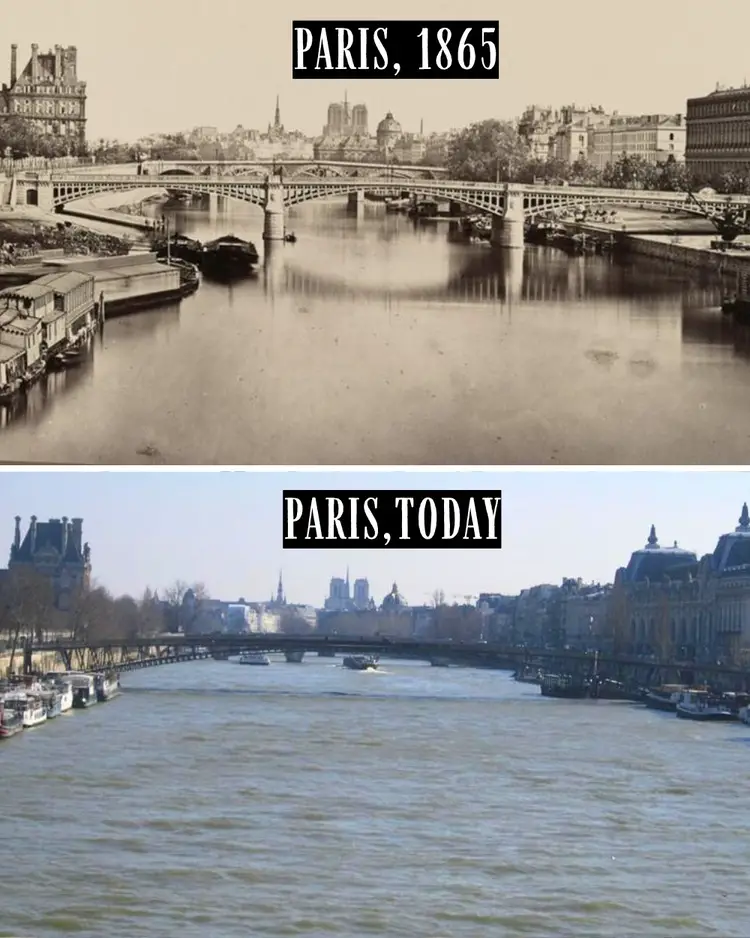
This photo shows the Pont des Arts and the Seine River in Paris, comparing 1865 and today.
The original iron bridge, built between 1802 and 1804, was designed like a garden over the river but became weak over time and partly collapsed in 1979.
It was rebuilt in the 1980s with modern materials while keeping its elegant look.
In the older photo, you can see the Palais d’Orsay, which was destroyed by fire in 1871; today, the Musée d’Orsay stands in its place, displaying famous art by Monet and Van Gogh.
Place du Louvre
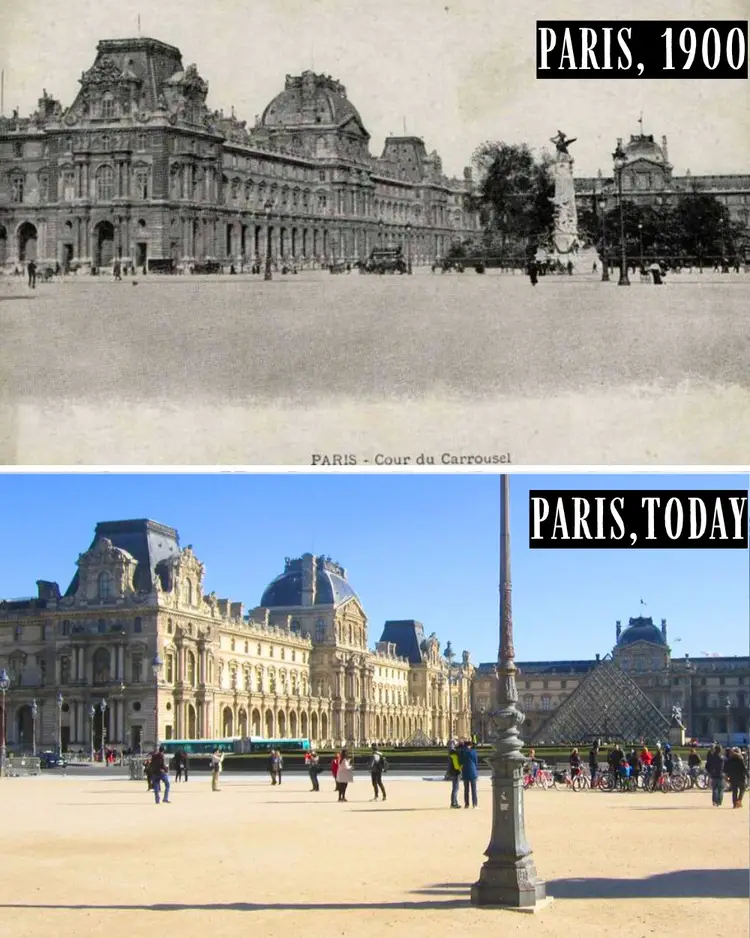
This photo shows a view of the Louvre courtyard from around 1900 and today.
In the old picture, you can see the classic details and architecture of the courtyard.
Today, it still holds its historic charm while welcoming visitors with modern touches.
Avenue des Gobelins

This photo shows Avenue des Gobelins in Paris.
The street was built during Haussmann’s renovation, which gave Paris wide boulevards and modern buildings.
It is named after the nearby Gobelins Manufactory, an old workshop that made beautiful tapestries.
In the distance, you can see the dome of the Panthéon, a famous monument where many important French people are buried.
The Bouquinistes
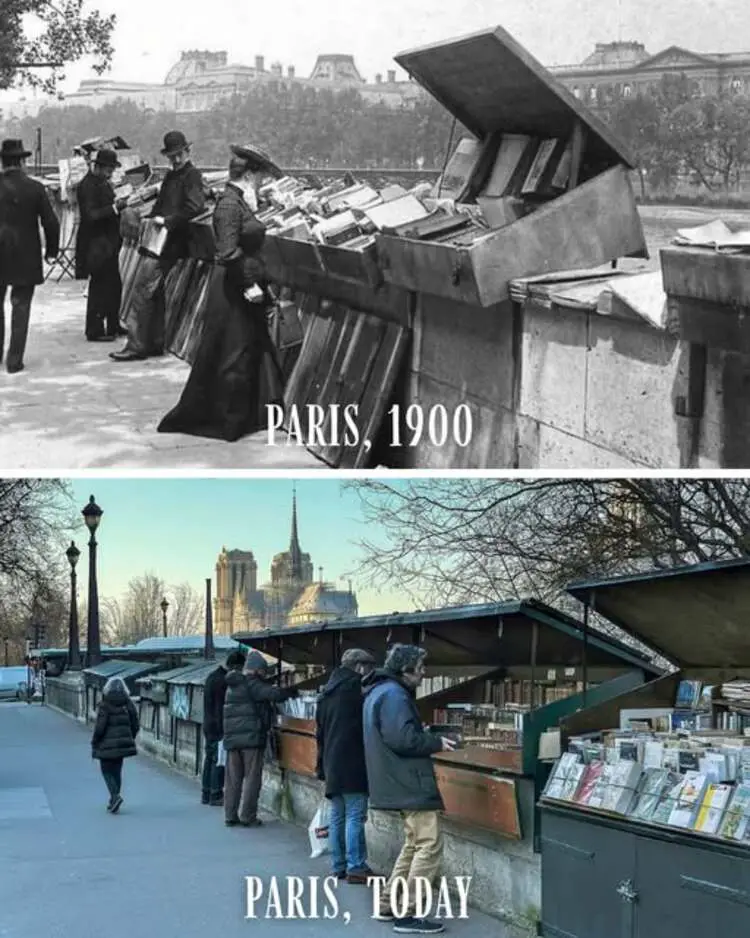
This photo shows the Bouquinistes along the banks of the Seine in Paris.
For centuries, these vendors have sold rare books, vintage postcards, posters, and charming souvenirs from their famous green boxes.
Their tradition adds a magical, old-fashioned touch to the city.
Place de la Contrescarpe
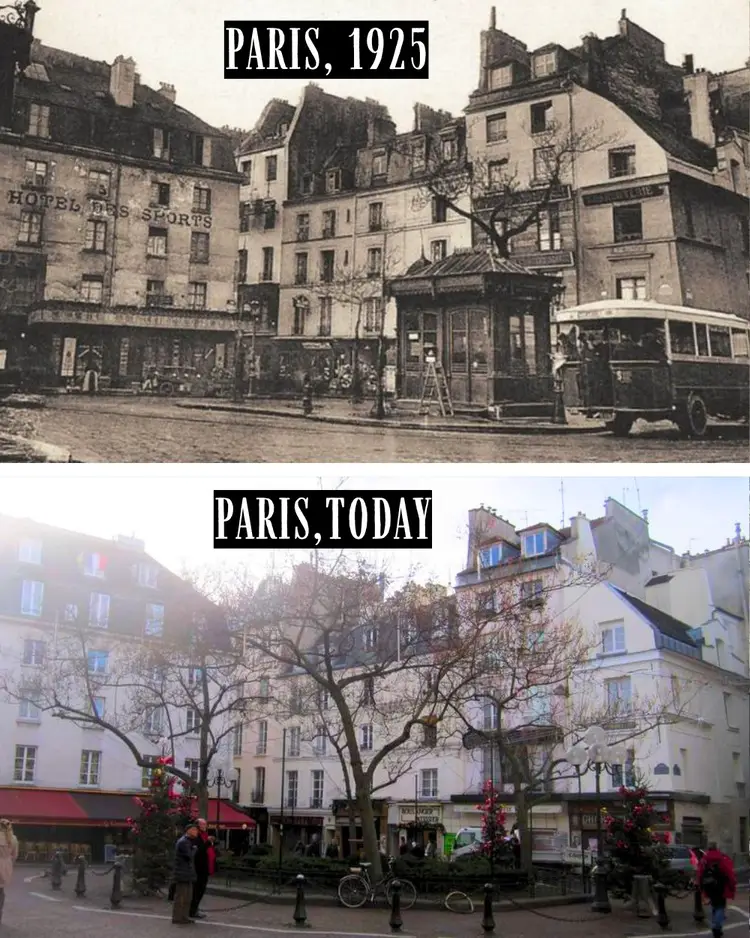
This photo shows Place de la Contrescarpe in Paris, comparing then and now.
In the older picture, you see a lively square filled with small shops and cozy cafés where people enjoyed quiet moments together.
Today, the square still keeps its charming, old-fashioned feel, making it a favorite spot for both locals and visitors.
Place Saint-Michel

This photo shows Place Saint-Michel and the Saint-Michel Fountain in Paris, comparing the past with today.
In the older picture, the square and fountain had a simpler look, yet they were full of life.
Today, the fountain still stands proudly in a busy square, keeping its charm and welcoming spirit for everyone to enjoy.
Place Sainte-Geneviève

This photo shows Place Sainte-Geneviève in front of the Saint-Étienne-du-Mont Church in Paris’s 5th arrondissement.
It is named after the old Abbey Sainte-Geneviève that once stood nearby.
The square is quiet and full of charm, making it a favorite spot for both visitors and filmmakers—it was even featured in the movie “Midnight in Paris” (2010).
Saint-Sulpice Church

This photo shows Saint Sulpice Church in Paris, comparing its look from the past to today.
In the old picture, you can see the church’s grand facade and tall bell towers with a simpler background.
Today, it still keeps its beautiful, historic architecture, but it’s now surrounded by the lively modern city.
Visitors continue to admire its detailed design and stained glass windows, making it a timeless landmark in Paris.
Pont Bir-Hakeim
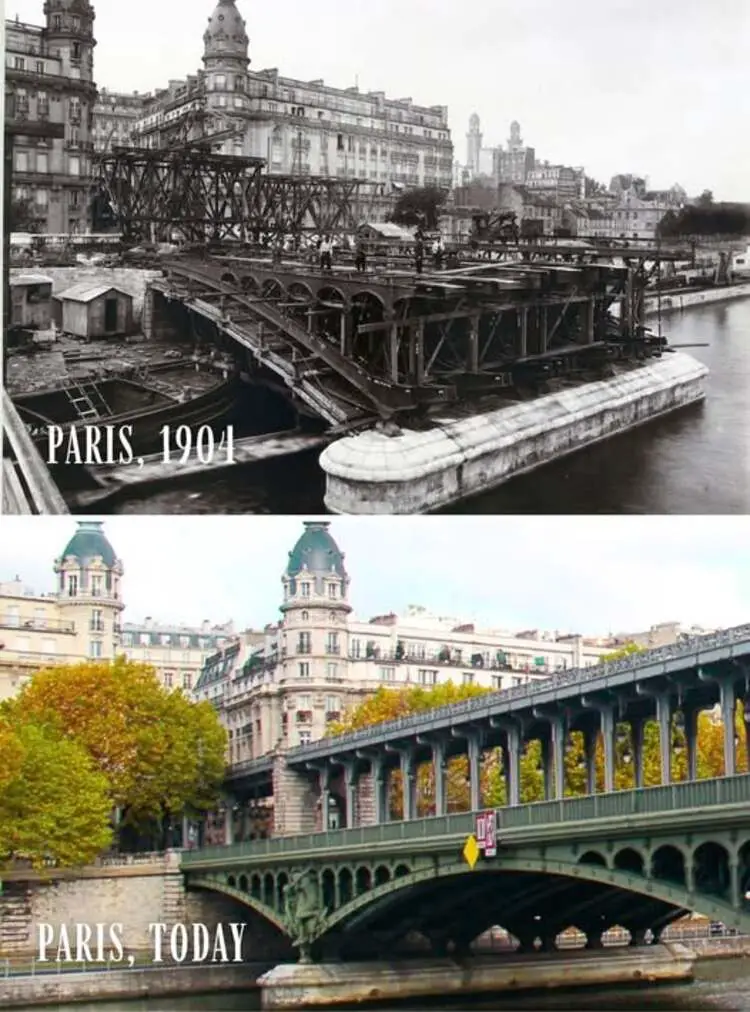
This photo shows the Pont de Bir-Hakeim in Paris, comparing its look from the past to today.
Built between 1903 and 1905 to replace the older Passerelle de Passy, the bridge has two levels: the upper level carries Metro Line 6 and the lower level is for cars and pedestrians.
Its unique steel design and open views make it one of the best spots to see the Eiffel Tower.
The bridge is also adorned with statues and art deco lamps, adding to its charm and making it an iconic landmark in Paris, often featured in movies.
Jardin du Luxembourg
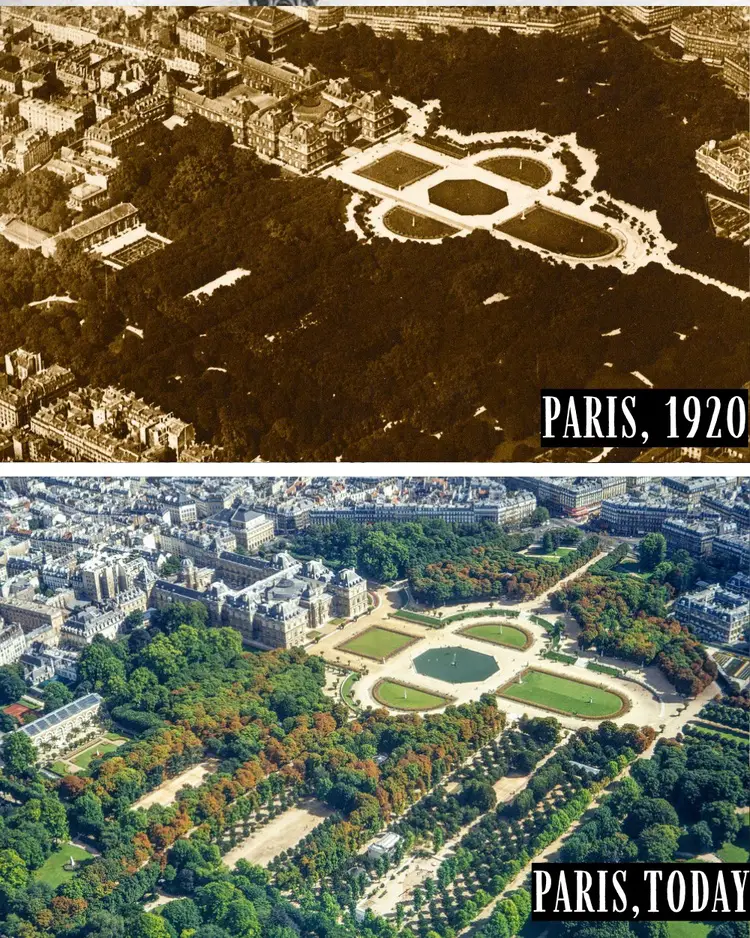
This photo shows the Luxembourg Gardens in Paris, comparing how they looked in the past to how they are today.
In the old picture, you can see the classic layout with tree-lined paths, pretty flowerbeds, and charming fountains.
Today, the gardens still keep their elegant statues and lovely design, but they are even more well-kept and popular as a peaceful place for both locals and visitors to relax and enjoy nature.
Saint-Germains-des-Prés Church

This photo shows Saint-Germain-des-Prés Church in Paris, one of the city’s oldest churches, built in the 6th century.
It was once part of a large abbey and named after Saint Germain, a bishop of Paris.
Over the centuries, the church survived wars, revolutions, and fires.
Because parts of it were rebuilt over time, you can see a mix of styles like Romanesque and Gothic, making it a unique piece of Parisian history.
Rue de l’École Polytechnique

This photo shows Rue de l’École Polytechnique in Paris, comparing 1870 and today.
In the old picture, the street was filled with horse-drawn carriages and old shops.
Now, it buzzes with modern cafés and restaurants. Located in the Latin Quarter—a historic area known for its vibrant student life—the street has kept its charm while adapting to modern times.
La Maison Rose
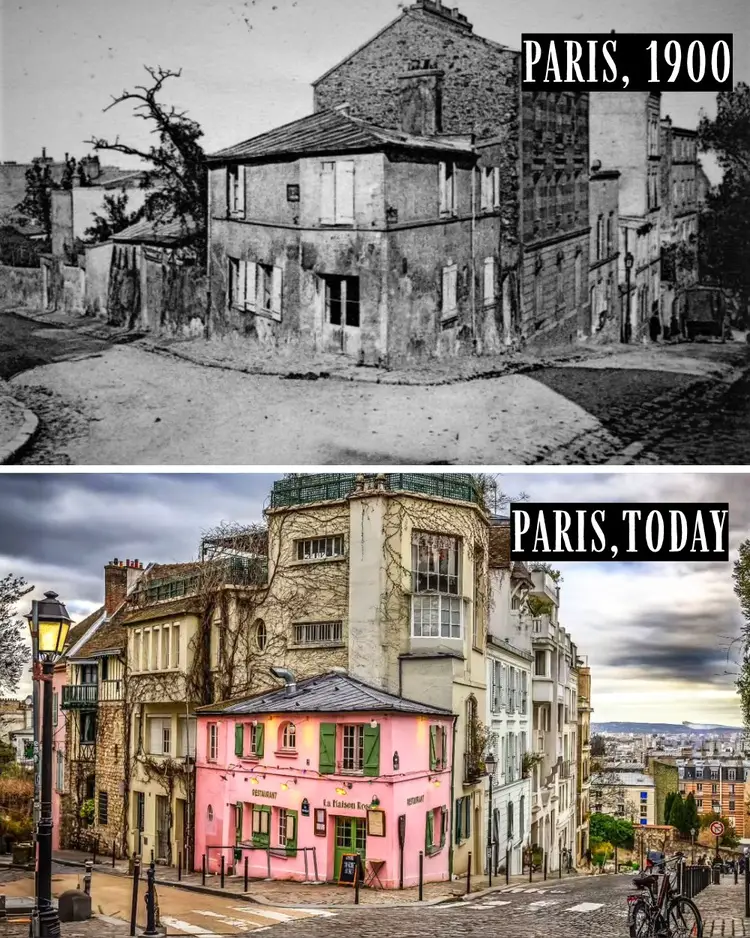
This photo shows La Maison Rose in Montmartre, Paris. Over 100 years old, it was once a favorite spot for artists like Picasso and Utrillo.
The charming pink café sits on a cobblestone street, surrounded by historic buildings and beautiful views.
Today, it still welcomes visitors with French food and drinks and remains a popular place for photos thanks to its unique color and storybook vibe.
Pont Saint-Michel
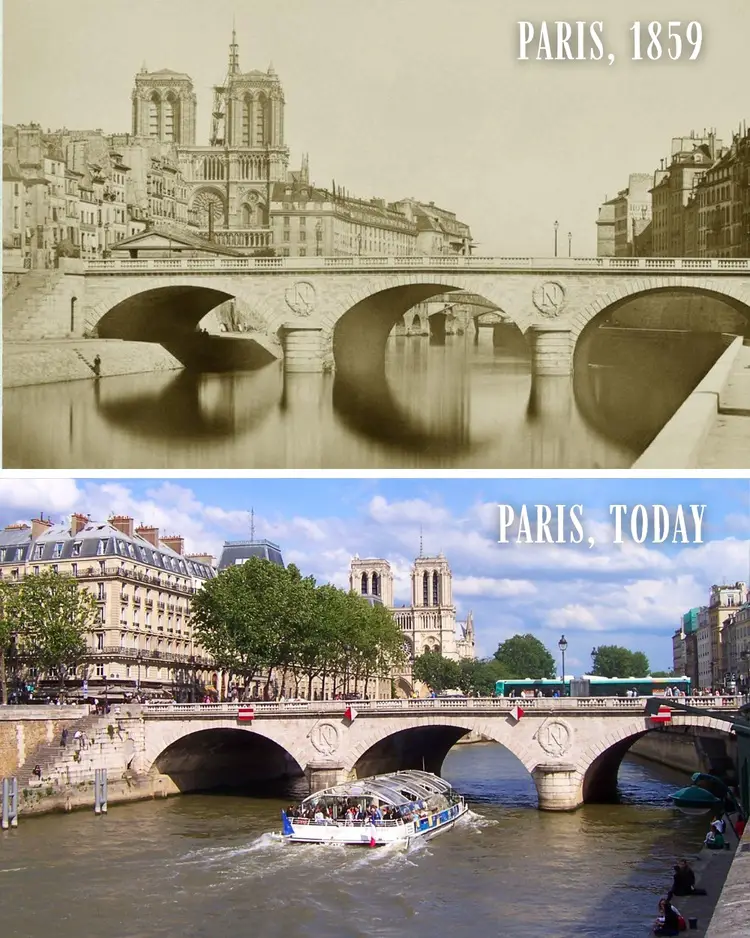
This photo shows Pont Saint-Michel in Paris, comparing its look from the past to today.
In the older picture, you can see a simple stone bridge spanning the Seine, with people strolling by and small boats floating along.
Today, the bridge still connects both sides of the river, blending its historic charm with the lively modern city.
It’s a favorite spot for visitors to enjoy beautiful views and take a walk through history.
Metro in Paris

This photo shows the Paris Metro in 1950 with its classic wooden benches, compared to today’s modern metro system.
In the older image, you can see the simple, traditional design with wooden seats and a more basic look.
Today, the metro has sleek, updated interiors with comfortable seating, digital displays, and a cleaner, more modern style—all while continuing to serve Parisians every day.
La Sorbonne
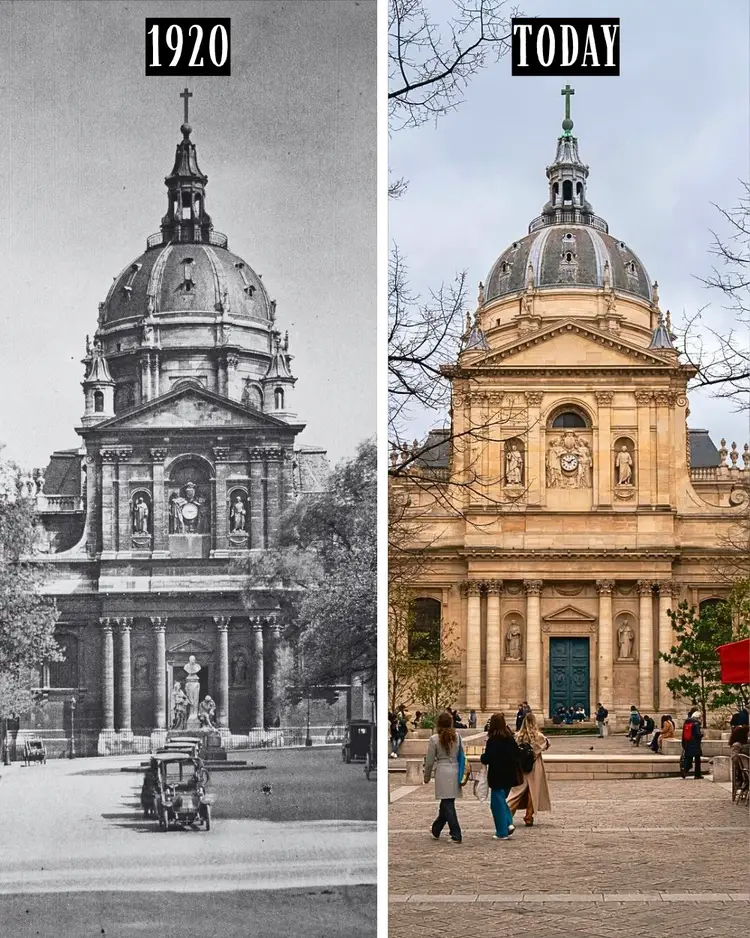
This photo shows La Sorbonne in Paris, one of the world’s most famous universities, located in the Latin Quarter.
Founded in the 13th century, it has long been a center for learning and culture, especially in philosophy, literature, and the arts.
The university is known for its beautiful buildings, including the iconic Sorbonne Chapel with its grand dome and elegant architecture.
Over the centuries, great thinkers and writers have studied and taught here, making it a timeless symbol of knowledge.
Rue de Rivoli
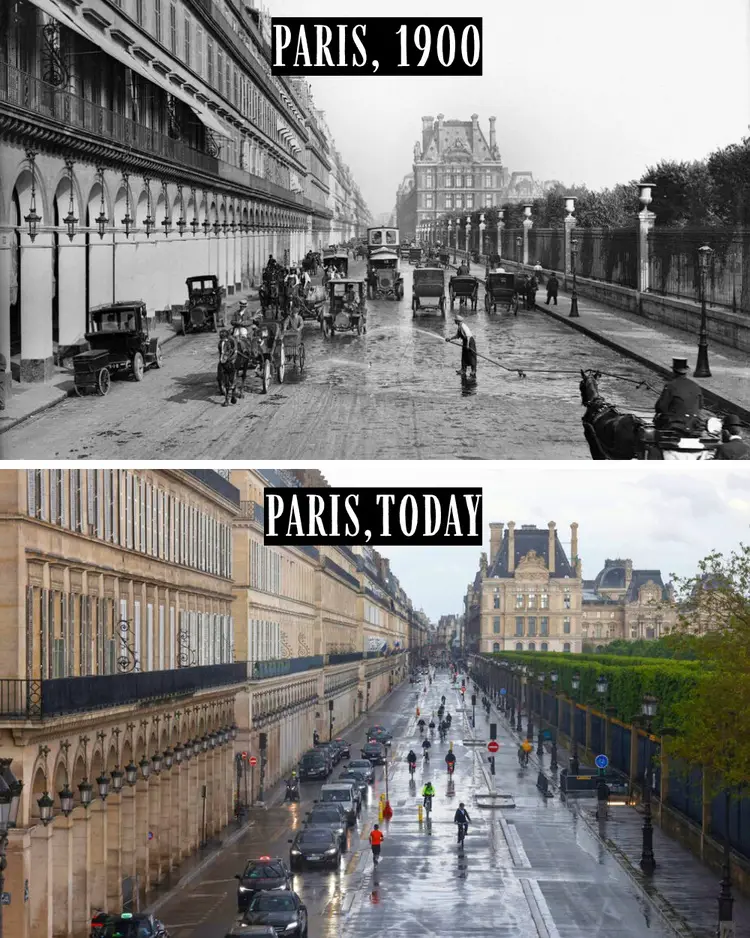
This photo shows Rue de Rivoli in Paris, comparing the past to today.
In the older picture, you can see someone watering the road—a small detail that shows daily life from a simpler time.
The beautiful buildings and wide street still give off a historic charm.
Today, Rue de Rivoli buzzes with modern shops and cafés, yet it retains its timeless elegance.
Avenue des Champs-Élysées

This photo shows Avenue des Champs-Élysées in Paris, comparing the past to today.
In the old picture, the street is empty, without any cars, giving it a calm and quiet feel.
Today, the avenue is filled with cars and people, bustling with life and energy, yet it still keeps its famous charm.
Champs de Mars
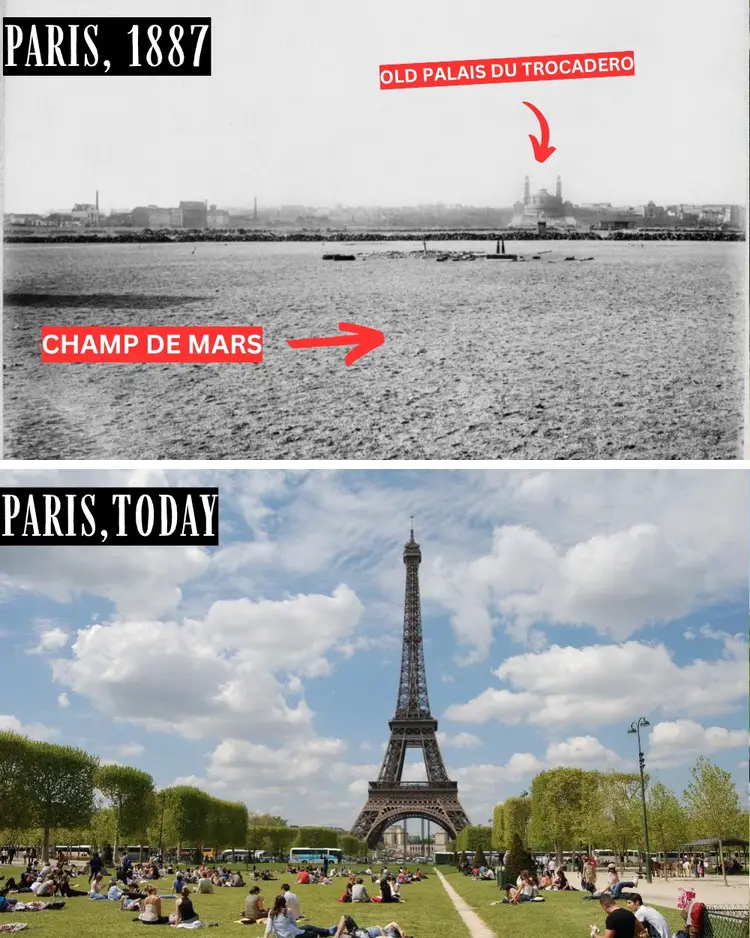
This photo compares the past and present of the area around the Champ de Mars and Trocadéro in Paris.
Before the Eiffel Tower was built in 1889, the Champ de Mars was an open field used for military training and events like the 1790 Fête de la Fédération.
The tower transformed the area, and today the Champ de Mars is a favorite spot for picnics and photos—especially when the tower lights up at night.
Across the Seine, the Trocadéro area once had the Moorish-style Palais du Trocadéro, which was replaced in 1937 by the Palais de Chaillot, offering one of the best views of the Eiffel Tower.
Seine Riverside during 1900 World Fair

This photo shows Paris during the 1900 World Fair.
In the old image, you can see large temporary pavilions built by countries like the United States, Ottoman Empire, and Germany along the Seine.
These impressive structures were taken down after the event, but the Passerelle Debilly—a footbridge built for the fair—is still visible today.
In the background, the old Palais de Trocadéro has been replaced by the modern Palais de Chaillot.
Rue du Soufflot
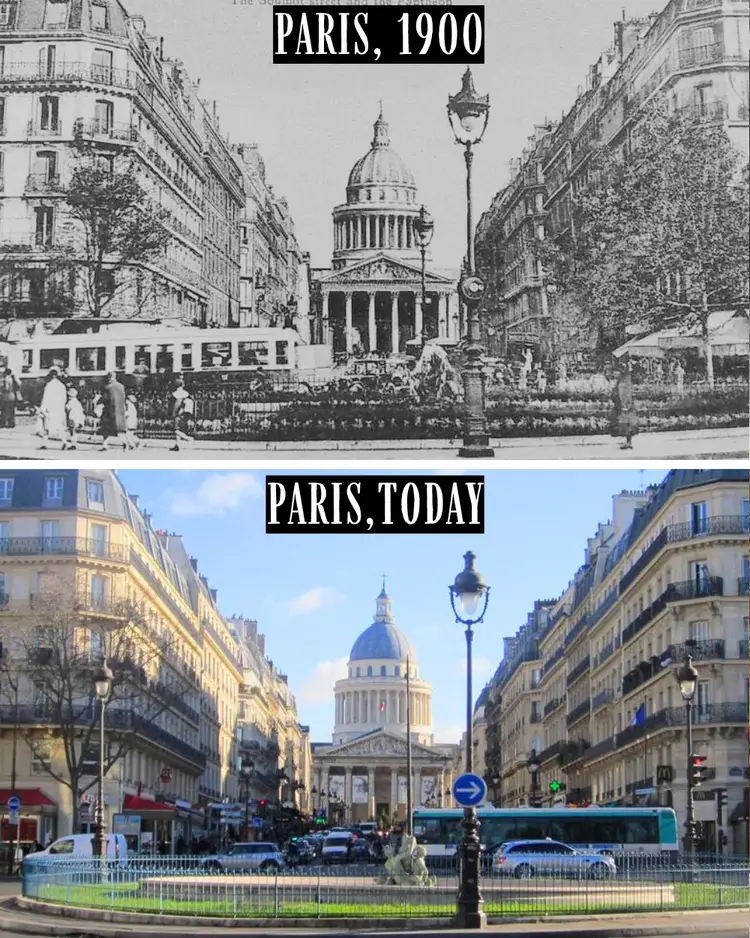
This photo shows Rue du Soufflot with the Pantheon in the background, comparing its look from the past to today.
In the older image, the street had a classic, timeless charm with the Pantheon standing proudly as a symbol of French history.
Today, Rue du Soufflot still retains its elegant character, and the Pantheon continues to serve as a majestic reminder of Paris’s rich cultural heritage.
Boulevard Saint-Martin
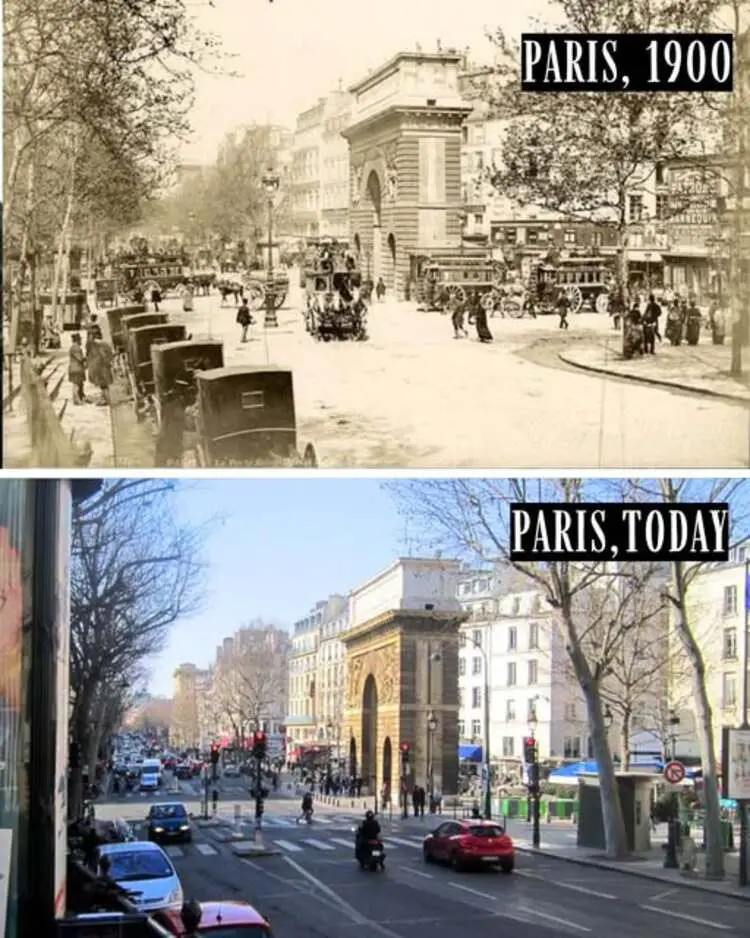
This photo shows Boulevard Saint-Martin, one of Paris’s iconic “Grands Boulevards,” as seen around 1900 and today.
In the old picture, the boulevard was lively with classic architecture and people strolling along the street.
Today, it remains a busy and vibrant part of Paris, keeping much of its historic charm while showing modern life in the city.
Théâtre de la Renaissance
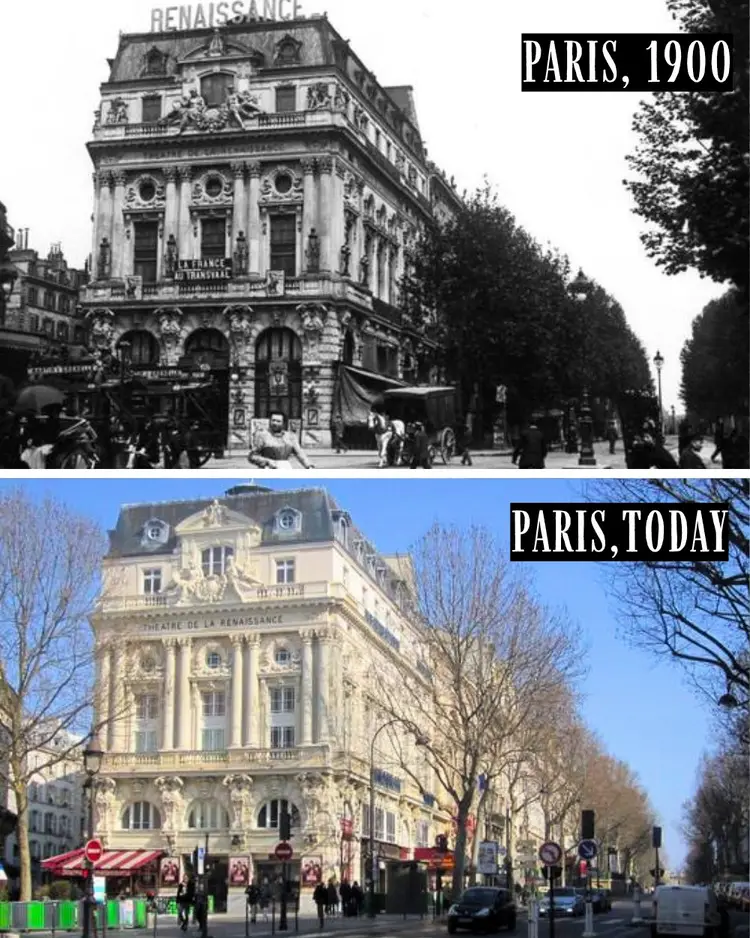
This photo shows the Théâtre de la Renaissance on Boulevard Saint-Martin.
Constructed in 1873, its Italian Renaissance-style architecture, inspired by the Opéra Garnier, makes it stand out as a true landmark.
In the old image, you can see its elegant facade and detailed design that captured the spirit of its time.
Today, the theatre still draws visitors with its timeless charm and historic beauty.
Place de Catalogne

This photo shows Place de Catalogne in the 14th arrondissement of Paris, comparing its past and present.
Originally, in the 1980s, it was a circular, stone-paved square designed by Catalan architect Ricardo Bofill.
In 2024, over 470 trees transformed it into a vibrant urban forest, creating a lively, green oasis in the heart of the city.
Rue des Chantres
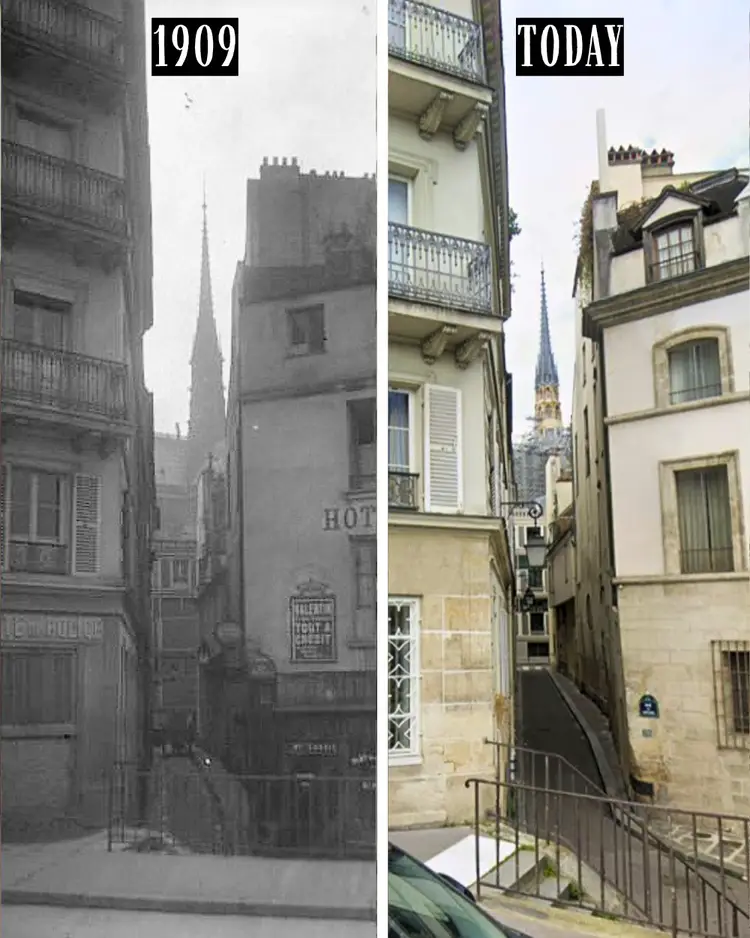
This photo shows Rue des Chantrés, a tiny, hidden street on Île de la Cité in Paris.
It is one of the narrowest streets in the city and hasn’t changed much over the years.
In the old picture, you can see the spire of Notre-Dame in the background, just like today.
This quiet street is full of history and was once home to the singers of the cathedral.
Champs de Mars
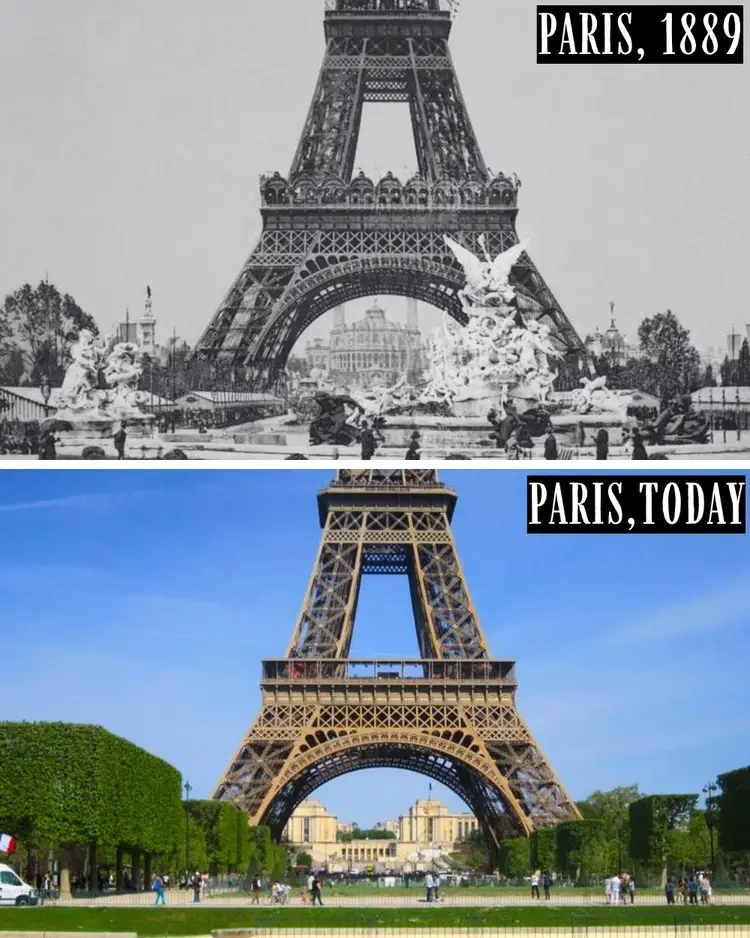
This photo shows the Champ de Mars during the 1889 Paris Universal Exhibition.
Back then, the field was filled with huge monuments like the Galerie des Machines and the Fountain of Jules Coutan.
The Eiffel Tower, originally meant to be temporary, was saved by Gustave Eiffel when he used it as a radio tower.
Today, the Champ de Mars is a popular park where people enjoy picnics and admire the tower’s impressive view.
World Exposition

This 1900 photo shows the World Exposition in full swing.
In the foreground, you see the Jardins du Trocadéro with its water basin.
On the sides, the Algerian pavilions were part of the colonial exhibition.
Behind them, the Pont d’Iéna connects to the Champ de Mars, and you can also spot the Palais de l’Électricité with its tall chimneys and the Grande Roue (Ferris wheel).
Over 48 million people visited this amazing event.
Buci Café
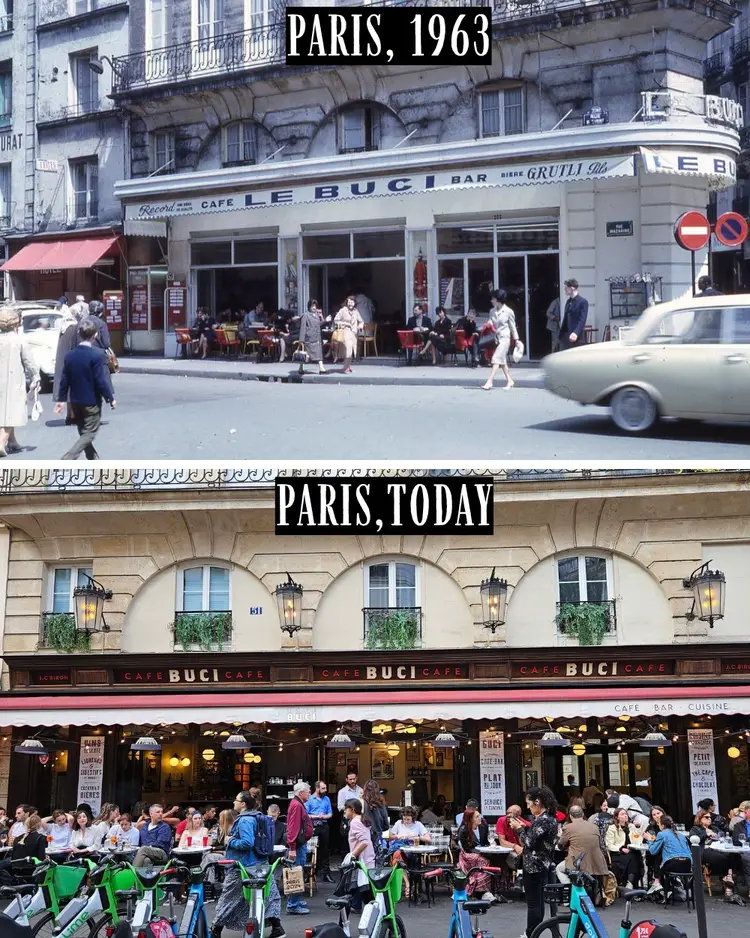
This photo shows Buci Café in Paris, where styles may change, but good coffee and people-watching remain timeless.
In the older image, the café had a charming, classic feel with customers enjoying their coffee while watching the world go by.
Today, even with modern updates around it, Buci Café still offers a warm atmosphere and delicious coffee—a perfect spot to relax and enjoy the busy street life.
Grand Palais
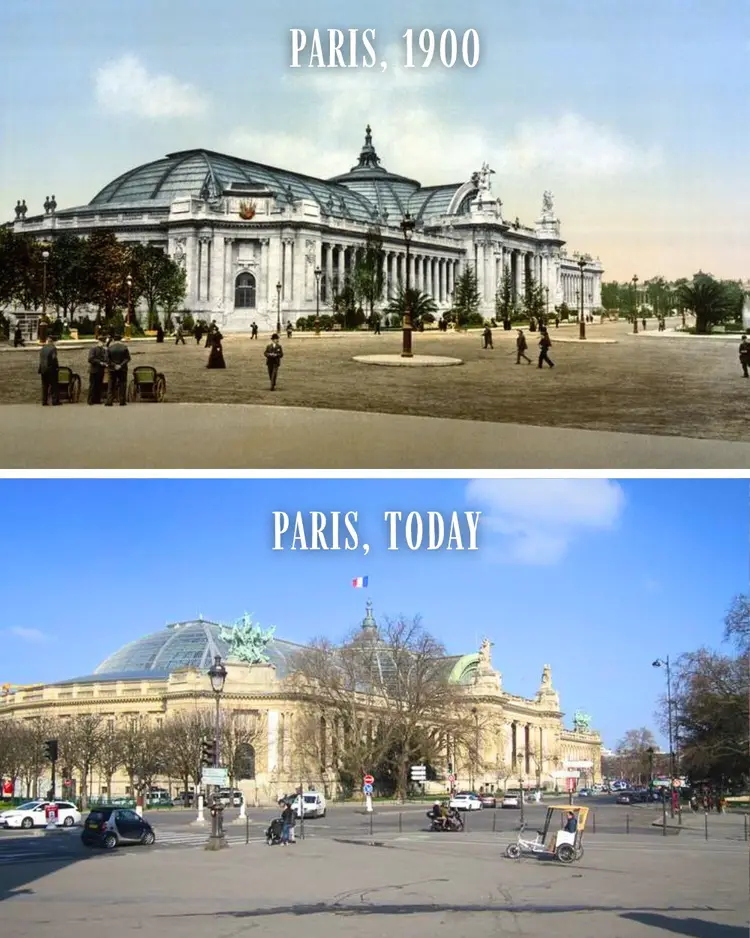
This photo shows the Grand Palais in Paris, comparing its look in 1900 to today.
Built for the World’s Fair in 1900, its stunning glass roof and elegant design captured the city’s imagination.
Today, the Grand Palais still hosts art exhibitions, fashion shows, and events throughout the year, blending its classic style with modern touches to remain one of Paris’s most iconic cultural landmarks.
The Louvre Pyramid
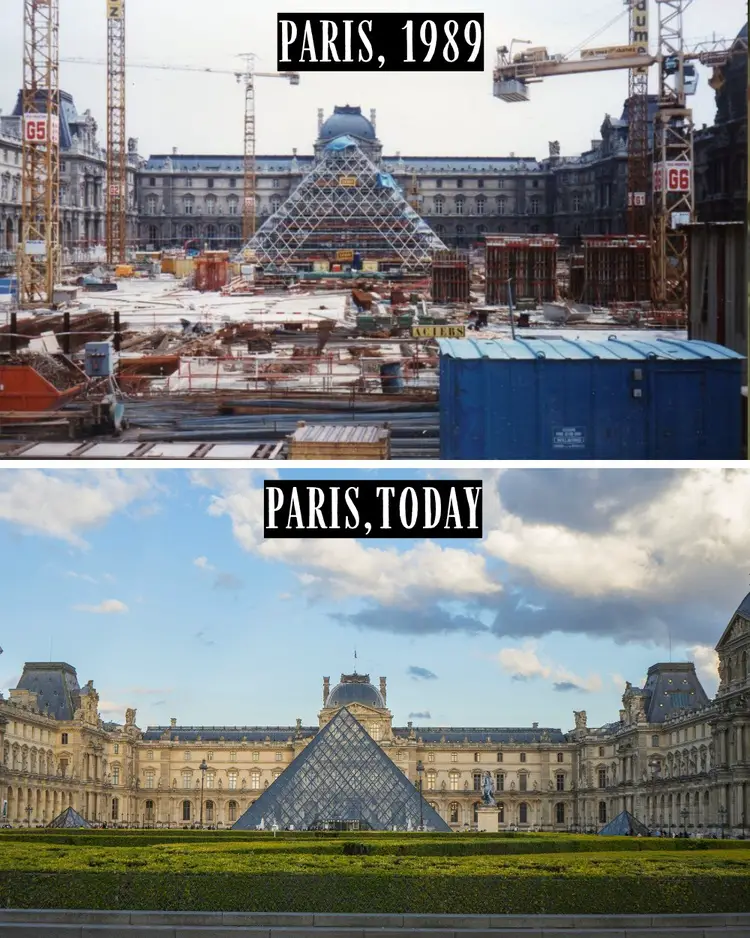
This photo shows the glass pyramid at the Louvre, comparing its early days to today.
Built between 1984 and 1989 and designed by architect I. M. Pei, it was a bold, modern touch on a historic building.
At first, many Parisians thought it didn’t fit with the old architecture.
Over time, however, it became one of Paris’s most iconic symbols.
Today, the pyramid serves as the main entrance to the museum, letting natural light fill the space below.
Louvre-Rivoli

This photo shows the Louvre-Rivoli Metro Station in Paris, capturing a notable event from 1991.
That year, a group of graffiti artists covered the station, known for its art displays, with vibrant tags and murals.
Their actions grabbed significant media attention and became an important moment in Paris’s graffiti history.
Since then, the station has been renovated and now resembles a mini museum, featuring art exhibits and displays that celebrate its unique past.
Le Petit Moulin

This photo shows Le Petit Moulin, a small and charming bar in the Montmartre neighborhood of Paris, comparing its past and present look.
In the older image, the bar’s quaint exterior and cozy atmosphere invite locals and artists alike.
Today, it still retains that warm charm, making it a beloved spot in Montmartre.
Grande Halle de la Villette

This photo shows how the Grande Halle de la Villette has changed over time.
In 1960, it was a huge meat market filled with cows and farmers.
Today, the building—still sporting its original iron structure—has been transformed into a vibrant space for concerts, shows, and exhibitions, bringing people together for culture instead of trade.
Porte Saint-Denis
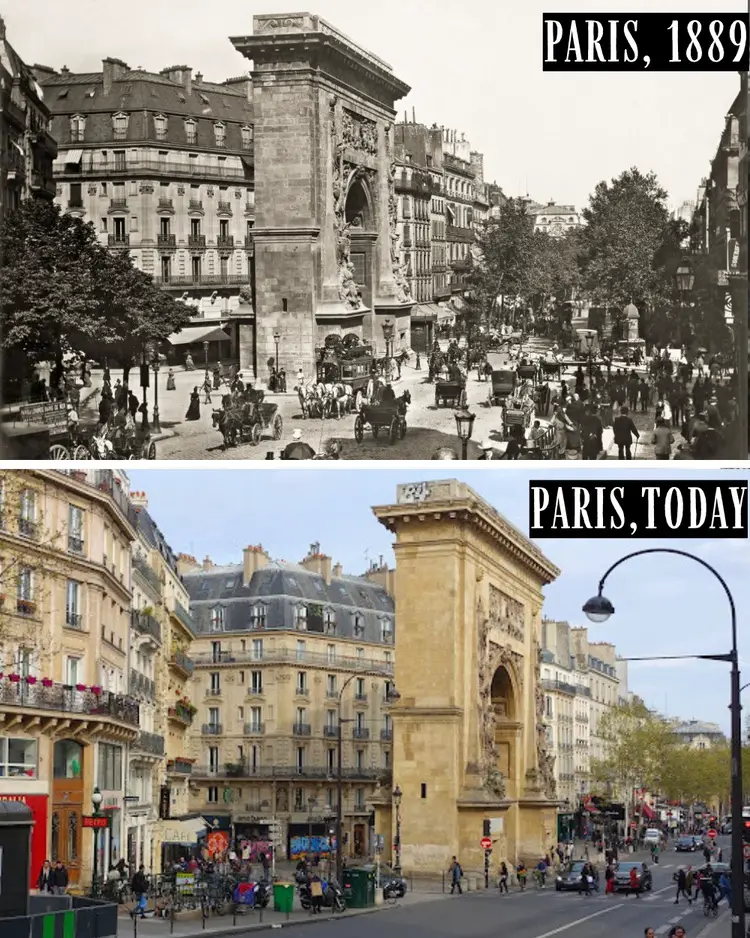
This photo shows Porte Saint-Denis in Paris, a big stone arch built in 1672 to honor King Louis XIV and mark the old entrance to the city.
Inspired by Roman triumphal arches, its detailed carvings celebrate the king’s victories.
Today, it stands in a busy area filled with shops and cafés, serving as one of Paris’s oldest monuments—a great place to explore history in the heart of the city.

With a passion for travel and having visited over 50 countries, Dorian is eager to share his favorite spots and expert tips to help you explore Paris and France like a local.

